Can You Bring Aerosols on a Plane? (Rules and Regulations)
Most passengers will likely want to bring an aerosol with them when they fly, whether that be deodorant, hairspray, shaving cream, or something else, so it’s important to know what the rules and regulations are when bringing aerosols on a plane.
In short, according to TSA regulations, every passenger must follow the 3-1-1 rule, which means that aerosols can be packed in both your carry on and checked luggage, though some restrictions will apply.
Table of Contents
- 1.1 Carry On Bags
- 1.2 Checked Bags
- 2 Flammable & Prohibited Aerosols
- 3 Will Aerosols Explode on a Plane?
- 4.1 Carry On
- 4.2 Checked Bags
- 5 How to Prevent Aerosols From Leaking or Spilling
- 6 Do Different Airlines Having Different Regulations?
- 7 Can You Bring Liquids on a Plane?

TSA Guidelines for Aerosols
Carry on bags.
The TSA have a rule in place called the 3-1-1 rule that stands for 3.4oz per passenger in a 1-quart sized bag.
This means that aerosols must not exceed 3.4oz/100ml if packed in your carry on, and each aerosol container must also be placed in a 1-quart sized, clear plastic, zip-top bag as you go through airport security.
Checked Bags
If you want to pack aerosols in your checked baggage, there are still restrictions, though they are far looser.
According to the TSA:
“The total aggregate quantity per person cannot exceed 2 kg (70 ounces) or 2 L (68 fluid ounces). The capacity of each container must not exceed 0.5 kg (18 ounces) or 500 ml (17 fluid ounces).”
Flammable & Prohibited Aerosols
Several aerosols are prohibited from being packed in either your carry or checked bags.
Prohibited aerosols that are flammable or otherwise hazardous that cannot be brought onto a plane include:
- Spray paint
- Cooking spray
- Aerosol laundry products
- Insecticides that aren’t sprayed onto skin
Will Aerosols Explode on a Plane?
Under normal circumstances, aerosols will not explode on a plane in either the cabin or cargo hold.
Only in exceptional instances, such as if the aerosol is exposed to extreme heat, will there be a possibility of the aerosol exploding.
Due to the higher likelihood of some highly flammable and hazardous aerosols exploding, some are forbidden to be taken on a plane, as mentioned above.
How to Pack Aerosols for Flying
There are a few important things to note if you want to bring aerosols on a plane.
- Make sure each aerosol container does not exceed 3.4oz/100ml.
- Place the aerosol container in a 1-quart, clear, resealable plastic bag.
- Due to a limit of 1-quart (32 ounces) , you’ll likely be able to fit no more than 7-8 100ml containers in the bag.
- Make sure the capacity of each aerosol container does not exceed 0.5 kg (18 ounces) or 500 ml (17 fluid ounces).
- Make sure the total aggregate quantity of the aerosols you want to bring do not exceed 2 kg (70 ounces) or 2 L (68 fluid ounces).
How to Prevent Aerosols From Leaking or Spilling
Aerosols can be prevented from leaking or spilling by following TSA guidelines, such as ensuring that any aerosol canister is protected by caps or other suitable means to prevent accidental release of the button/nozzle.
Do Different Airlines Having Different Regulations?
Whether you’re flying with Southwest, JetBlue, United, Delta, American Airlines, or any other major or regional airline domestically or internationally, such as with British Airways, the same rules apply.
So, aerosols must be no larger than 3.4oz/100ml if packed in your carry on, and the total aggregate quantity per person cannot exceed 2 kg (70 ounces) or 2 L (68 fluid ounces), with the capacity of each container not exceeding 0.5 kg (18 ounces) or 500 ml (17 fluid ounces).
Can You Bring Liquids on a Plane?
The 3-1-1 Rule applies to liquids and gels, as well as aerosols.
So if the container contains either a liquid, gel, or is an aerosol, it must be no larger than 3.4oz/100ml.
Remember, the 3-1-1 rule applies to the size of the container, so it doesn’t matter if you have a 200ml container than only contains 50ml of liquid – it still wouldn’t be allowed in your carry on.
Ella Dunham
Ella Dunham, a Freelance Travel Journalist and Marketing Manager, boasts an impressive career spanning eight years in the travel and tourism sectors.
Honored as one of "30 Under 30" by TTG Media (the world’s very first weekly travel trade newspaper), a "Tour Operator Travel Guru" and "Legend Award" winner, Ella is also a Fellow of the Institute of Travel, a Member of the Association of Women Travel Executives, has completed over 250 travel modules, and hosts travel-focused segments on national radio shows where she provides insights on travel regulations and destinations.
Ella has visited over 40 countries (with 10 more planned this year).
Related Posts:

Everything You Need to Know About the TSA’s Liquid Limit
The tsa allows liquids under 3.4 ounces in your carry-on—but what’s considered a “liquid” isn’t always obvious..
- Copy Link copied

Don’t forget to remove your liquids when going through TSA screening.
Photo by Jaromir Chalabala/Shutterstock
Whether you’re a carry-on-only kind of person or not , knowing the Transportation Security Administration’s (TSA) liquid limits is essential for anyone who travels by plane in the United States. Yet understanding which of your toiletries, foods, and other items even count as “liquid”—let alone how best to pack them—can get confusing. Use this guide to understand the TSA’s rules and restrictions about liquids, common exceptions, and tips to help ensure your next airport security screening goes smoothly.
What is the TSA liquid limit?
The TSA’s liquid limit for carry-ons—known as the 3-1-1 rule—allows travelers to pack liquids, aerosols, gels, creams, and pastes under 3.4 ounces (100 milliliters) in their carry-on bags. Passengers are allowed up to one quart-sized bag per person , or roughly nine 3.4-ounce containers in a single quart-sized bag. Anything more will have to go in a checked bag or risk being tossed out.
If your liquids are stored in containers larger than 3.4 ounces, even if there’s only 3.4 ounces left inside the bottle, you can’t bring them through security.
Completely empty bottles, such as your reusable water bottle , are allowed through the TSA checkpoint since (spoiler alert!) they don’t contain any liquids at that moment.
Which toiletries TSA allows in your carry-on
The TSA allows all of the following common toiletries in your carry-on only in containers that are 3.4 ounces or less:
- Shampoos and conditioners
- Lotions and sunscreen
- Gel hair products
In other words: yes, you can bring toothpaste, deodorant, and sunscreen through TSA checkpoints but only if they are in travel-sized containers.
Powders and powder-like substances, including baby powder and some makeup items, aren’t restricted in your carry-on bag. But if you’re carrying more than 12 ounces (350 milliliters) of a powder, you’ll need to place it in a separate bin for X-ray screening, and it may be subject to additional screening—so it’s a good idea to budget an extra few minutes at the security checkpoint if you think this might happen.
Tips for packing your toiletries in your carry-on

To comply with TSA regulations, invest in small, reusable toiletry bottles, like these capsules by Cadence.
Courtesy of Cadence
Especially if you don’t have TSA PreCheck , it’s helpful to pack all of your toiletries in a quart-sized (or smaller) clear plastic toiletry bag for screening. Although improved airport technology means that far fewer air passengers (both in PreCheck and non-PreCheck lines) will have to take their liquids out out of their carry-on, it’s still helpful to have all of your liquids in one bag just in case you get pulled aside for additional screening. For an upgrade from that large Ziplock, we recommend the standard-sized Clarity Jetset Case from Truffle ($88), which has a clear window panel and is comparable in size to a quart-sized bag.
Since toothpaste is considered a liquid, paste, or gel by the TSA, most of us toss those tiny one-ounce tubes in our carry-on bags. However, if you want to ditch the hard-to-recycle packaging, consider toothpaste tablets, an ecofriendly alternative that’s not subject to the 3-1-1 rule. We like Humankind’s fluoride toothpaste tablets ($12), which resemble small mints and turn to paste when you crush them between your teeth. Matador has also recently released a reusable toothpaste tube ($10), which you can fill (and refill) with your regular toothpaste.
For travel toiletries that are easy to rebottle (like shampoo or body wash), consider investing in reusable bottles or containers so you can always keep your preferred brand on hand. Some of our favorite TSA-approved toiletry bottles include:
Buy Now: GoToob three-pack of 3.4-ounce bottles, $30, rei.com
These easy-to-fill, leakproof silicone tubes are ideal for shampoos, conditioners, lotions, and body washes. GoToob’s line comes in a variety of sizes, ranging from 1.7 to 6 ounces, and are easy to clean between refills.
Matador FlatPack
Buy Now: $13 for one or $35 for three, matadorup.com
Each three-ounce, TSA-approved bottle is made from a durable, waterproof, nylon-based fabric. Like GoToob, they’re leakproof and easy to fill, but thanks to their flexible, fabric-like design, they will shrink to their contents, taking up less space in your pack. >> Read the full review of the Matador FlatPack
Buy Now: $14 for one or $74 for six, keepyourcadence.com
The refillable travel containers by Cadence are small, leakproof “capsules” that click together with magnets. At 0.56 ounces, they’re best for makeup and toiletries you don’t need much of—like a weekend’s worth of shampoo or a week of that under eye cream you only need a dab of.
Foods are subject to liquid limits
The TSA’s 3-1-1 rule applies to food too, meaning you’ll need to make sure any foods that count as liquids, gels, or pastes (like yogurt, peanut butter, pâté, jams, or that tasty pimento cheese spread you tried to bring home from Charleston) are less than 3.4 ounces or packed in your checked bag. There are some exceptions, like frozen foods and juice for babies, and the TSA’s website is the best resource to check for specific items.
Exceptions to TSA’s liquids rule: Full-sized liquids that you can bring through security
The TSA has several important exemptions to its liquids rule. You’re allowed to bring full-sized bottles of the following:
Hand sanitizer: Due to the coronavirus pandemic, the TSA currently allows travelers to bring up to 12 ounces of hand sanitizer in their carry-on bags. These will be screened separately.
Medication: You’re allowed to bring medically necessary liquids, aerosols, and gels through security. This also includes the ice or gel packs you may need to keep your medications cool. You are not required to store these items in a plastic, resealable bag, but you should remove them from your luggage and let the TSA officer know what you’ve packed.
Baby formula and breast milk: Like medication, you can bring freezer packs to keep these items cool, and you should remove them from your luggage and notify an agent when you go through security. More baby-related exceptions? Gel or liquid-filled teethers and canned or jarred baby food.
Of course, the final decision on whether an item is allowed through the checkpoint rests with the TSA officer.
If you’re ever unsure about a specific item, the TSA’s website has a handy, searchable list of prohibited and allowed items worth checking before you travel. You can also now text the TSA with your questions.
This article was originally published in 2022. It has been most recently updated on March 21, 2023, with additional information.

Area Socios

TRAVEL WITH AEROSOLS
Aerosol air travel tips.
Preparing your luggage for air travel has become increasingly complicated, especially when it comes to toiletries. For many airlines, aerosols in particular are a cause for confusion because they contain flammable gases. Aerosols are completely safe. Just stick to some basic rules when taking them on a plane.
Here are some tips as to what can and cannot be carried in your hand luggage, and how to pack it.
Aerosols fall into the category of liquids and therefore cannot exceed 100 ml (maximum container capacity). Aerosols containing higher amounts must go in checked baggage, and it is advisable to make sure that the container is tightly closed and protected so that the button is not pressed during the flight.
There are exceptions, such as aerosols purchased at airport shops after going through the security checkpoint. Medicine in aerosol form can also be carried, along with its medical prescription.
Aerosols and other liquids carried in hand luggage must be placed in a transparent, resealable plastic bag with a total capacity of no more than one liter (approximately 20 x 20 cm). For example, a freezer slider-top bag can be used.
Only one bag is allowed per passenger, including children. The bag’s contents must fit comfortably, and the bag with its contents must close completely. Therefore, the number of products should be limited to the amount that will fit in the bag.
Removing this bag from your hand luggage and placing it into a tray or directly on the X-ray belt will facilitate and expedite the work of airport security staff.
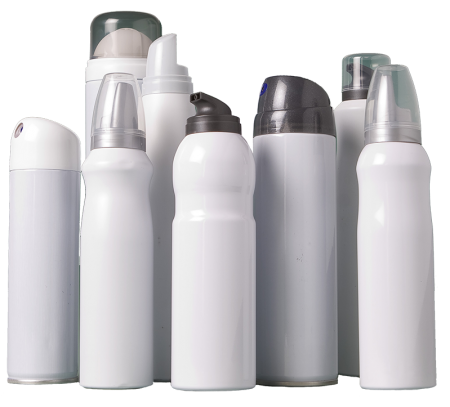
Remember that the only types of aerosols permitted on a plane are toiletries and medicine. Other items such as paints or DIY products should not be transported.
Disclaimer: AEDA provides this information based on data gathered up until the date of publication. It should only be taken as informative advice. Please familiarize yourself with your company’s requirements before travelling, as they may vary in some respects. To learn more about this topic, please refer to the Spanish airports website: www.aena.es “
Resumen de Cookies
Las cookies necesarias son absolutamente esenciales para que el sitio web funcione correctamente. Esta categoría solo incluye cookies que garantizan funcionalidades básicas y características de seguridad del sitio web. Estas cookies no almacenan ninguna información personal.
Las cookies que pueden no ser particularmente necesarias para que el sitio web funcione y se utilizan específicamente para recopilar datos anónimos del usuario a través de análisis, anuncios y otros contenidos integrados se denominan cookies no necesarias. Es obligatorio obtener el consentimiento del usuario antes de ejecutar estas cookies en su sitio web. Analíticas: Nos permiten recoger información puramente estadística y anónima (no se registra ningún dato que te pueda identificar) del comportamiento en la web. Con qué navegador acceden, cuanto tiempo están en cada página, desde qué enlace han llegado a la página…Principalmente hacemos este seguimiento a través de la herramienta Google Analytics, que instala cookies consideradas de primera parte (no afectan a la privacidad del usuario porque los datos guardados son anónimos).

Can You Bring Aerosol on a Plane? Carry On and Checked Bags
John Parker
Navigating airport security can often feel like a puzzle, especially when it comes to items that may be subject to strict regulations, such as aerosol cans.
Whether you’re a beauty enthusiast with your favorite hairspray, a parent with essential disinfectant sprays, or someone who likes to be prepared, you might find yourself wondering: Can you bring aerosol on a plane?
In this post, we’ll uncover the mysteries of airline regulations regarding aerosols in both carry-on and checked luggage. We’ll provide you with the latest guidelines so you can pack with confidence and breeze through TSA without a hitch. Get ready to demystify the do’s and don’ts of flying with aerosol products!
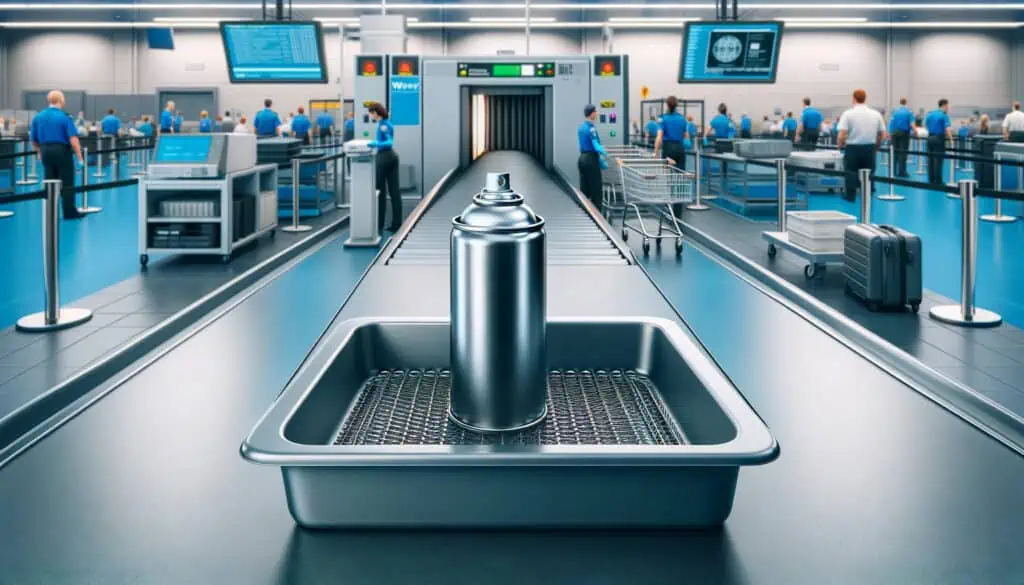
The Quick Answer: Can you take aerosol cans on a plane? TSA rules allow aerosols on a plane in carry on baggage but they must be in containers that are 3.4 ozs (100ml) or less. They can be packed in checked baggage almost without any size restrictions. Aerosols containing flammable liquids are prohibited in both carry on and checked bags.
Can you fly with aerosols in checked baggage?
Checked baggage really is the best place to travel with aerosols on a plane since then you will not have to worry about the size restrictions for anything containing a liquid, as the 3.4 ounces rule does not apply.
Although you can take quite a few aerosols in checked luggage, there is a limit on the size and total amount. The TSA website states that “toiletry aerosols” that are carried in a checked bag must not exceed 70oz (68 fluid ounces) in total, and each container must be 18oz (16 fluid ounces) or less.
Unless you are a traveling aerosol salesman, you are unlikely to exceed this limit under normal circumstances.
Many people believe that aerosols may explode in their checked bags – if you want reassurance that they will not, then you may wish to read my post – Will aerosols explode in checked bags?
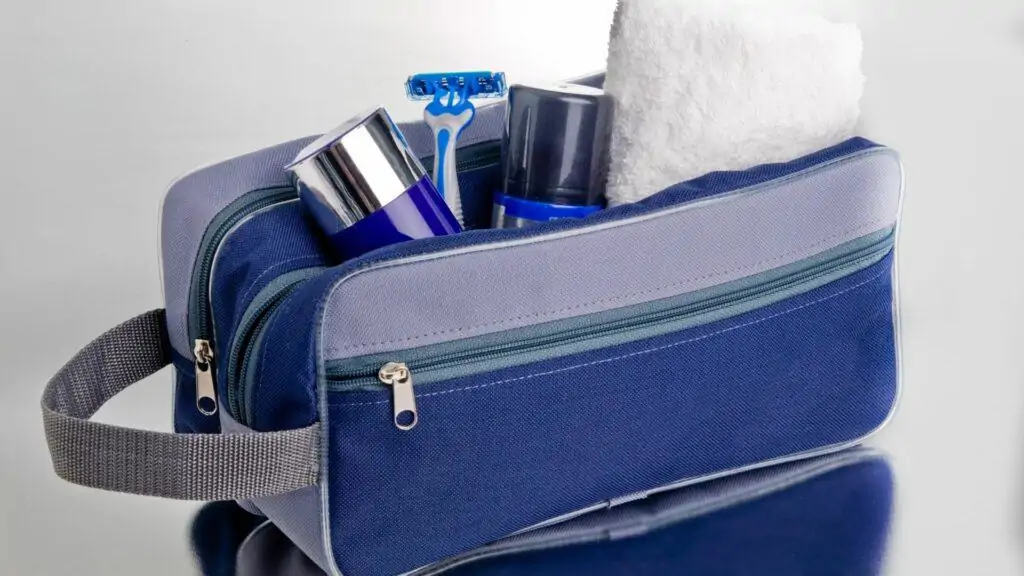
Can you put spray deodorant in checked luggage?
Can you put aerosol deodorant in checked luggage? Yes, you can. As well as deodorant, you can also put aerosols in checked luggage if they contain the following:
- antiperspirant
- dry shampoo
- perfumes /aftershave
- shaving foam or gel
- tanning spray
- fly spray/insecticides – however, they are allowed in checked baggage as long as they are not labeled as hazardous material (HAZMAT), so look out for the hazard warnings.
- air fresheners
- personal protection sprays such as mace and pepper spray – see separate rules later in this post
This passenger is asking the TSA on Twitter “Can aerosol cans go in checked bags”:
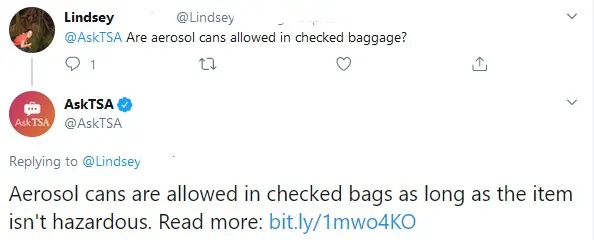
This is the link they refer to – bit.ly/1mwo4KO
Restrictions for aerosols in checked baggage
There are a few exceptions, some of which sound strange as, on the face of it, they do not seem dangerous, and others where I wonder why anyone would want to take any with them at all.
Most of these are not banned because they are more likely to explode in checked baggage under normal circumstances than other aerosols. They are banned because they may explode and fuel the fire in the unlikely event of a baggage hold fire.
Most of these are potentially flammable liquids in aerosols, and they include:
- spray paint
- spray oils and penetration spays
- Lysol spray
- cooking spray
- spray starch and other aerosol laundry products
Although these items are not always contained in aerosols (but can be) they are not allowed either:
- CO2 Cartridges
- Fire Extinguishers and Other Compressed Gas Cylinders
- Recreational Oxygen
- Compressed air
This is the TSA’s response on Twitter to a passenger asking about taking bug spray in checked bags:

The FAA has a very good article showing exactly what you can and can’t take on board an aircraft with you. Hazardous Materials: Carried by airline passengers and crew members .

Can you take an aerosol in carry on?
The rules for taking aerosols in carry on bags are much more restricted than those for taking aerosols in checked baggage, as you will see below.
Aerosol sizes
You can bring aerosols through the TSA checkpoint at the airport, but they are subject to some of the TSA airport security regulations, particularly the liquid rules that apply to hand luggage.
This surprises some people as they often do not consider aerosols to contain a liquid, so they are frequently confiscated by TSA agents.
How many fluid ounces can you take on a plane depends on the size of the aerosol containers. This is the main issue with being able to take them through the TSA checkpoint rather than the fact that they are an aerosol.
Only aerosol cans that are 3.4oz/100ml or smaller in size, regardless of the amount of liquid they actually contain, can go in your carry-on bags. Generally, this means that aerosols should be packed in your checked bags since most aerosols contain substantially more liquid than this.
This is the TSA responding to a passenger’s question regarding can they take a 10 oz aerosol can of sunscreen on a plane:

Can you bring travel size aerosol cans on a plane?
If you can, buy your deodorants and other toiletry aerosols in travel-size cans that are smaller than 3.4 oz (100ml), just like the one on the right in this picture below. Travel size are allowed in your carry on luggage and will pass the security check.

To find out more about traveling with liquids, read my full article about the max liquid carry on rules and the TSA 3-1-1 liquids rule.
How to take aerosols through the TSA checkpoint
The Transportation Security Administration rules apply to all liquids, including those contained in aerosols, and state that they must be separated from your carry-on baggage and placed in a transparent, resealable quart-sized bag in a separate bin.
Only one quart-sized liquids bag is allowed per passenger.
All aerosols larger than 3.4 ounces will be confiscated by airport security if you try to take them in your carry on bags.
This passenger is asking the TSA on Twitter can you take aerosols on a plane if they have this airplane symbol and means this aerosol can be taken in her carry on bag:
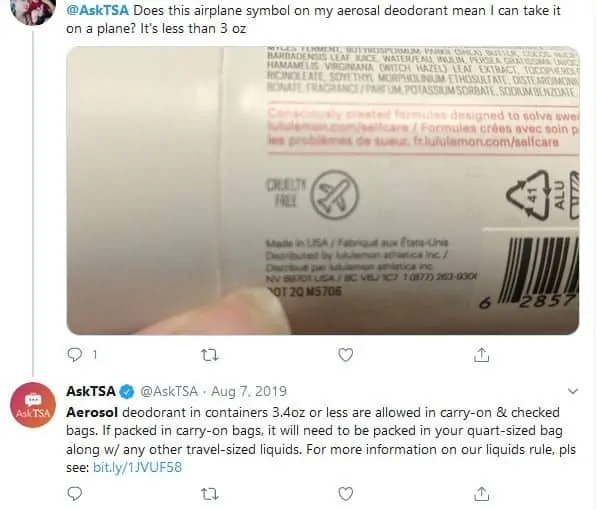
What type of aerosols can you take through the TSA checkpoint
Provided they are in containers no larger than 3.4 ounces (100m) and in a quart-sized plastic bag, then you can take aerosol toiletry products containing most types of liquid through the TSA checkpoint.
What aerosols are not allowed on planes?
However, the TSA rules for aerosol sprays prohibit the following:
- Fly spray/insecticide/bug spray
- Self-defense sprays , including pepper spray, tear gas etc
- Spray paint
- Spray oils, including cooking spray, oils and starch
- Aerosol lubricants/spray oil
- flat tire repair spray
This is a notice from the TSA on Twitter regarding flammable aerosol sprays:

TSA aerosol cans rules
Remember the liquid size rules for hand luggage are that containers with liquids should be no larger than 3.4oz/100ml and be in a quart-size liquid bag when referring to this table, which shows the aerosol can TSA rules for both hand luggage and checked bags.
Note 1: Allowed in checked bags as long as they are not labeled as containing hazardous materials (HAZMAT) Note 2: You are only allowed one container of self-defense spray in your hold luggage, which cannot be larger than 4 oz/118ml. It must be fitted with a safety mechanism or catch to ensure it does not go off by accident. They are not allowed if they contain more than 2 percent of tear or cs gas.
How to take larger aerosol sprays in a carry on bag

In practice, the liquids rule only applies to items taken through airport security in your hand luggage. It doesn’t apply to what can actually be taken into the cabin of the plane.
What I mean by that is, assuming there are stores in the departure area of the airport you are flying from (after going through airport security), then you may buy standard-size aerosol products (bigger than 3.4 ounces) in those stores to take with you on board.
That way, you could take your favorite spray deodorant, antiperspirant, shaving cream or whatever with you, assuming the stores at the airport sell it, rather than trying to find travel-size versions before you go.
Can you use aerosol on planes?
You may use any aerosol spray you are permitted to take on the plane while onboard.
Clearly, you would have no reason to use some that are permitted, but you may want to use aerosol toiletry items. Ideally, you should use these in the aircraft restroom to avoid disturbing other passengers.
Can you take flammable aerosols on a plane?

You are not permitted to pack flammable aerosol in checked baggage or aerosol spray cans that contain flammable liquid in your hand luggage. These include such items in an aerosol can as oil (WD 40 type and even cooking oils), paint, starch (used in laundry) or Lysol .
So if you are flying somewhere to do street art, you must buy your paint when you arrive.
How to pack aerosol cans for flying
In 40+ years of flying, I have never had any problems with carrying aerosol cans in checked baggage on planes. But if you are still concerned about putting aerosols in your checked baggage, then there are a few things you can do to give yourself some peace of mind:
- Pack aerosols in a resealable quart-size bag in case it leaks. You don’t want the contents going all over your clothes. This is a much better idea for the non-aerosol liquids in your luggage, which are more likely to leak onto your clothes (which has happened to me).
- Don’t let them rattle around. Ensure that they cannot move and bang together. Putting them in plastic bags between your clothes or in your shoes helps.
- If there is a safety mechanism or catch, then ensure this is in operation so there cannot be an accidental release.
- If you really want to be ultra-safe, and they are brand new, then perhaps release a little of the contents, and therefore the pressure, in the can.
In airports worldwide, strict regulations are enforced to ensure the safety of passengers and crew members. One important rule concerns the transport of aerosol spray on planes. These pressurized containers, which emit fine particles of liquid or gas when sprayed, are commonly used for various purposes, such as personal care products, cleaning supplies, or even insect repellents.
However, due to safety concerns related to the potential flammability and explosion risks associated with aerosols, there are specific guidelines in place for their transportation. Passengers are generally allowed to carry aerosol spray on planes, provided that the containers do not exceed a certain volume (typically 100 ml or 3.4 ounces) and are properly packed in a transparent, resealable plastic bag.
Additionally, it is crucial to inform the airline staff about the presence of aerosols in one’s luggage during security checks, as their contents need to be inspected and approved for transportation. This rigorous control ensures the safe journey of both passengers and the aircraft, maintaining the highest standards of aviation security.
Aerosol FAQs
Can you bring aerosol sunscreen on a plane .
You can bring aerosol sunscreen in carry-on if the container is no larger than 3.4 ounces. If larger than this, it will have to go in checked bags.
Can you check aerosol bug spray on a plane?
Aerosol bug spray cannot be carried in carry-on bags. It must be packed in your checked baggage.
Can you bring aerosol deodorant on a plane?
You can bring aerosol deodorant in carry on if the container is no larger than 3.4 ounces. If larger than this, the aerosol deodorant will have to go in checked bags.

I have been traveling around the world by air since the early 70s and living overseas too. I worked for British Airways for a number of years and I am also a private pilot. About Me
Sharing is caring!
Latest posts

The Ultimate Carry On Checklist for Long Flights

Can You Use Bluetooth on a Plane? Debunking Myths

What is a Personal Item? Uncovering the Mystery
Air Travel Questions
Can You Bring Aerosol Cans On A Plane? TSA Rules in 2023
April 25, 2023
Ethan Harris
Table of Contents
Can You Bring Aerosol Cans on a Plane?
If you’ve ever wondered, “Can You Bring Aerosol Cans on a Plane?” you’re not alone. This article will answer this question and cover TSA guidelines , liquid rules, and what you can and cannot pack in your carry-on and checked luggage. So, let’s dive in!
The Short Answer: Yes, But With Some Restrictions
Good news, folks! You can bring aerosol cans on a plane, but there are some rules you need to follow. The main thing to remember is that aerosol cans, like hair spray, dry shampoo , and deodorant, must comply with the TSA’ s 3-1-1 rule for carry-on bags. The 3-1-1 liquids rule states passengers can bring 3.4-ounce (100 ml) containers of liquids, gels, and aerosols in their carry-on baggage. These containers must fit in a clear, quart-sized, resealable plastic bag.
However, not all types of aerosol cans are allowed . For example, flammable aerosols such as spray paint and pepper spray are prohibited in carry-on and checked baggage .
TSA Twitter Answer
Thanks for your question, Sara. Since the pictured bug spray is more than 3.4oz, it must be placed in checked bags. For more info on the liquids rule, please see: https://t.co/F7bT8Rd06Y — AskTSA (@AskTSA) March 25, 2018
Carry-On Luggage
Pack travel-sized aerosol containers like hair mousse, suntan lotion, and spray deodorant in your carry-on luggage. Remember that each container’s capacity must not exceed 3.4 fluid ounces (100 ml) and must fit in a clear plastic, quart-sized, zip-top bag.
It’s also essential to know that baby food, breast milk, and formula are exempt from the 3-1-1 liquids rule. However, they might require additional screening at the TSA checkpoint.
Checked Luggage
In your checked luggage, you can pack larger containers of aerosol products, such as full-size aerosol containers of antiperspirant, hair spray, and dry shampoo. However, the total volume of aerosol cans should not exceed 68 fluid ounces (2 liters) per passenger.

Prohibited Items
Flammable aerosols, like spray paint and pepper spray, are not allowed in either carry-on or checked baggage . Also, radioactive materials, sharp objects, and certain powder-like substances are prohibited.
Tips for Packing Aerosol Cans
- Ensure your aerosol cans have a safety mechanism to prevent accidental release during transit.
- It’s a good idea to place your aerosol cans in a sealed 1-quart plastic bag to avoid leakage.
- If you’re unsure about the size restrictions, check the TSA website for the latest rules and guidelines.
Hazardous Materials and Airport Security
Regarding air travel, airport security has strict regulations on hazardous materials. TSA agents ensure passengers follow these rules to maintain a safe flying environment.
Hand Luggage and Flammable Liquids
Flammable liquids such as hand sanitizer are allowed in limited quantities in your hand luggage. The TSA rules state that hand sanitizer containers should not exceed 3.4 ounces (100 ml) and must be packed in a clear, quart-sized, resealable plastic bag.
Security Checks and Aerosol Sprays
During security checks, a TSA officer may inspect your hand luggage for prohibited items, including certain aerosol sprays. If you carry aerosol cans that are not compliant with the regulations, they may be confiscated by the Transportation Security Administration (TSA).
Domestic Flights and Travel Tips
The rules for carrying aerosol cans and other personal items are generally the same for domestic flights. However, it’s always a good idea to double-check the regulations with your airline to avoid any surprises at the airport.
Travel-Sized Containers and Necessary Liquids
When packing for a trip, it’s best to use travel-sized containers for your necessary liquids, including toiletries and personal care products. These smaller containers allow you to comply with the 3-1-1 liquids rule and make it easier to pass through airport security.
TSA Carry Regulations and Dangerous Goods
The TSA and the Federal Aviation Administration (FAA) work together to enforce regulations regarding dangerous goods, such as flammable liquids and aerosol spray cans. To ensure a smooth travel experience, familiarize yourself with the rules and pack your items accordingly.
The Best Way to Pack Aerosol Cans
The main reason for these restrictions is to ensure the safety of all passengers on board. When packing aerosol cans, like a container of hairspray or a larger can of deodorant, follow these tips:
- Use travel-size, 3.4-ounce (100 ml) containers for carry-on luggage.
- Place aerosol cans in a clear, quart-sized, resealable plastic bag.
- Pack larger cans within the limits set by the TSA for checked luggage.
- Make sure your aerosol cans have a safety mechanism to prevent accidental release.
Q: Can I bring hair gel and other items to my carry-on? A: Yes, as long as they comply with the TSA liquids rules and are in containers of 3.4 ounces (100 ml) or less.
Q: Can I bring nail polish on a plane? A: Nail polish is allowed in carry-on luggage if it complies with the 3-1-1 liquids rule.
Q: Can I bring insect repellent on a plane? A: Insect repellent is allowed in carry-on and checked luggage but must follow the size and packaging guidelines.
Q: Are there specific rules for international flights? A: The rules for domestic and international flights are generally the same, but it’s best to check with your airline for additional restrictions.
Q: Can I bring an assortment of aerosol toiletry products in my carry-on?
A: Absolutely! You can bring an assortment of aerosol toiletry products in your carry-on, provided they are in containers no larger than 3.4 ounces (100 ml) and fit inside a clear, quart-sized, resealable plastic bag.
So, there you have it! You can bring aerosol cans on a plane but with some restrictions. Remember to follow the TSA guidelines, pack your aerosol products in suitable containers, and check the latest rules for

Aerosols: Small Particles with Big Climate Effects
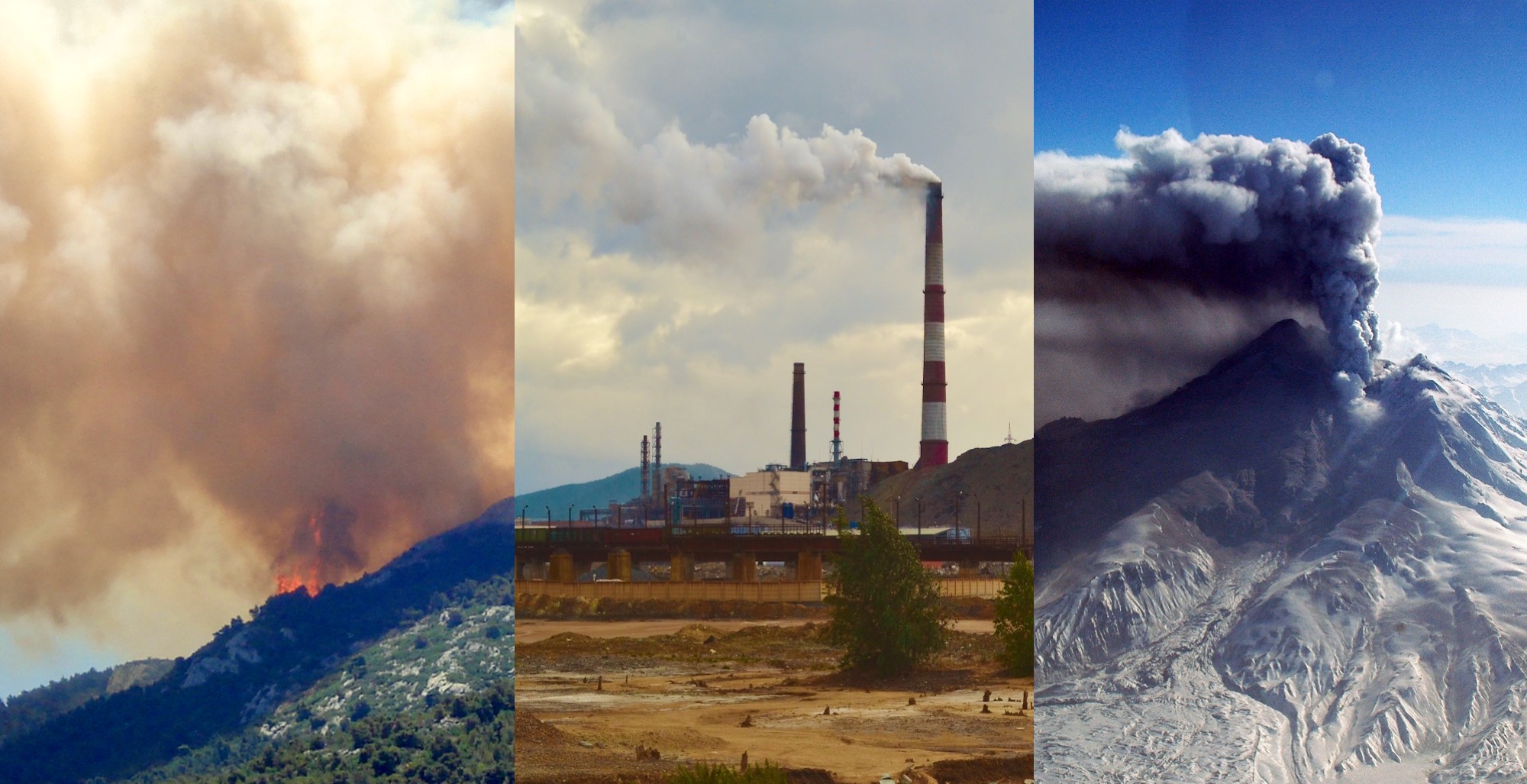
Aerosols are small particles in the air that can either cool or warm the climate, depending on the type and color of the particle.
We often think of aerosols as spray paint, insect repellant, or similar substances sprayed from a can. But aerosols are actually small particles or droplets that float in the air, and it turns out these little particles can have big effects on Earth’s climate.
Aerosols come in many forms. They can be natural, like wildfire smoke, volcanic gases, or salty sea spray. Human activities can also generate aerosols, such as particles of air pollution or soot.
The role of aerosols in climate science is complex. In general, light-colored particles in the atmosphere will reflect incoming sunlight and cause cooling. Dark-colored particles absorb sunlight and make the atmosphere warmer. Because different types of particles have different effects, aerosols are a hot topic in climate research.
Volcanoes Make Natural, Cooling Aerosols
Explosive volcanic eruptions can inject gases all the way into the stratosphere , which is the layer of the atmosphere that begins around 33,000 feet (10,000 meters) overhead.
Volcanoes emit sulfur dioxide gas, which combines with water in the atmosphere to form tiny particles that can circle the globe and stay in the air for a few years, depending on how big the plume is and how high it goes. These light-colored sulfate aerosols block incoming sunlight and cool the atmosphere. Mount Pinatubo’s enormous eruption in 1991 is a recent example. The sulfates from the eruption cooled the atmosphere by 0.7 to 0.9° F (0.4 to 0.5 °C) and made 1992 and 1993 the coolest years in the past 35 years.
Air-Pollution Aerosols Also Have a Cooling Effect
Burning fossil fuels releases sulfate particles and sulfur dioxide (SO 2 ) which, like volcanic aerosols, can reflect sunlight and make the atmosphere cooler. Unlike volcanic aerosols, air pollution does not travel very high in the atmosphere, so it only lasts for 3 to 5 days. But air pollution aerosols are produced continuously, so these particles are a constant presence.
In an ironic twist of climate science, air pollution caused by burning fossil fuels has a slight cooling effect on the planet, which is the opposite of the warming caused by greenhouse gases. But there’s nothing beneficial about air pollution for the environment or human life. Air polluted by fossil fuels leads to the premature death of around 8 million people globally each year. Tiny particles emitted during fossil fuel combustion can be inhaled, and they can cause asthma, respiratory infections, lung cancer, and heart disease.
The COVID-19 pandemic showed what can happen if the humans reduce their aerosol pollution. Fossil-fueled air travel, driving, electricity use, and industrial activity all decreased sharply in the spring of 2020. This led to cleaner, clearer air, which caused a slight warming -- up to 0.2 to 0.5° F (0.1 to 0.3° C) -- in some places. But at the same time, this reduction in air pollution was estimated to have saved 11,000 lives in Europe and 77,000 lives in China. And people in some cities enjoyed clear horizons and views for the first time in years.
Soot Is a Dark-Colored Aerosol That Warms the Climate
Soot is made of dark particles of carbon from burning fossil fuels, wood, or other plant matter. These dark particles absorb sunlight and warm the atmosphere. Soot leads to additional warming when it settles onto snow and ice because it makes the surface darker, which causes faster melting.
Wildfires, cooking fires, industrial activities, and diesel engines are major sources of soot. Reducing soot emissions would have a quick cooling effect on the atmosphere, which would bring the added benefit of improving human health.
Aerosols and Clouds Are at the Forefront of Climate Science
Scientists are working to better understand the ways aerosols interact with clouds. Some aerosols from human pollution can change the size or lifetime of water droplets inside clouds. When water droplets become smaller, clouds reflect more sunlight. Overall, this has a cooling effect on the atmosphere. Similarly, some aerosols like dust can influence how ice particles form in colder clouds. This is an area of active research, so stay tuned for updates as the science develops.
The Warming Effect of Greenhouse Gases Is Larger Than the Cooling Effect of Air Pollution
If not for aerosol pollution, Earth would be even warmer than it already is. Aerosol air pollution has made the planet about 0.7° F (0.4 °C) cooler than it otherwise would be, according to the 2021 report by the Intergovernmental Panel on Climate Change (IPCC). For comparison, greenhouse gas emissions have added 2.7°F (1.5°C) of warming.
This makes for an interesting predicament. It might seem that air pollution is oddly helpful to counteract climate change. But that doesn’t mean we need air pollution to keep the world slightly cooler. As people and economies shift to energy forms that emit less particulate pollution, there will be a gradual reduction in air pollution aerosols, which could cause a temporary warming effect. Because these changes will occur gradually over several decades, it’s unlikely to cause much of a temperature rise.
Over the long haul, reducing emissions of heat-trapping gases will more than make up for any temporary warming. Plus, cleaner air will save millions of lives.
More Resources
NASA aerosol visualization showing smoke plumes, dust clouds, and salt spray from tropical storms
Check your understanding of clouds and aerosols with a NASA quiz from the Know Your Earth series.

Related Terms
- Climate Science
- Earth's Atmosphere
Explore More

Antarctic Sea Ice Near Historic Lows; Arctic Ice Continues Decline
Sea ice at both the top and bottom of the planet continued its decline in 2024. In the waters around Antarctica, ice coverage shrank to near-historic lows for the third year in a row. The recurring loss hints at a long-term shift in conditions in the Southern Ocean, likely resulting from global climate change, according […]
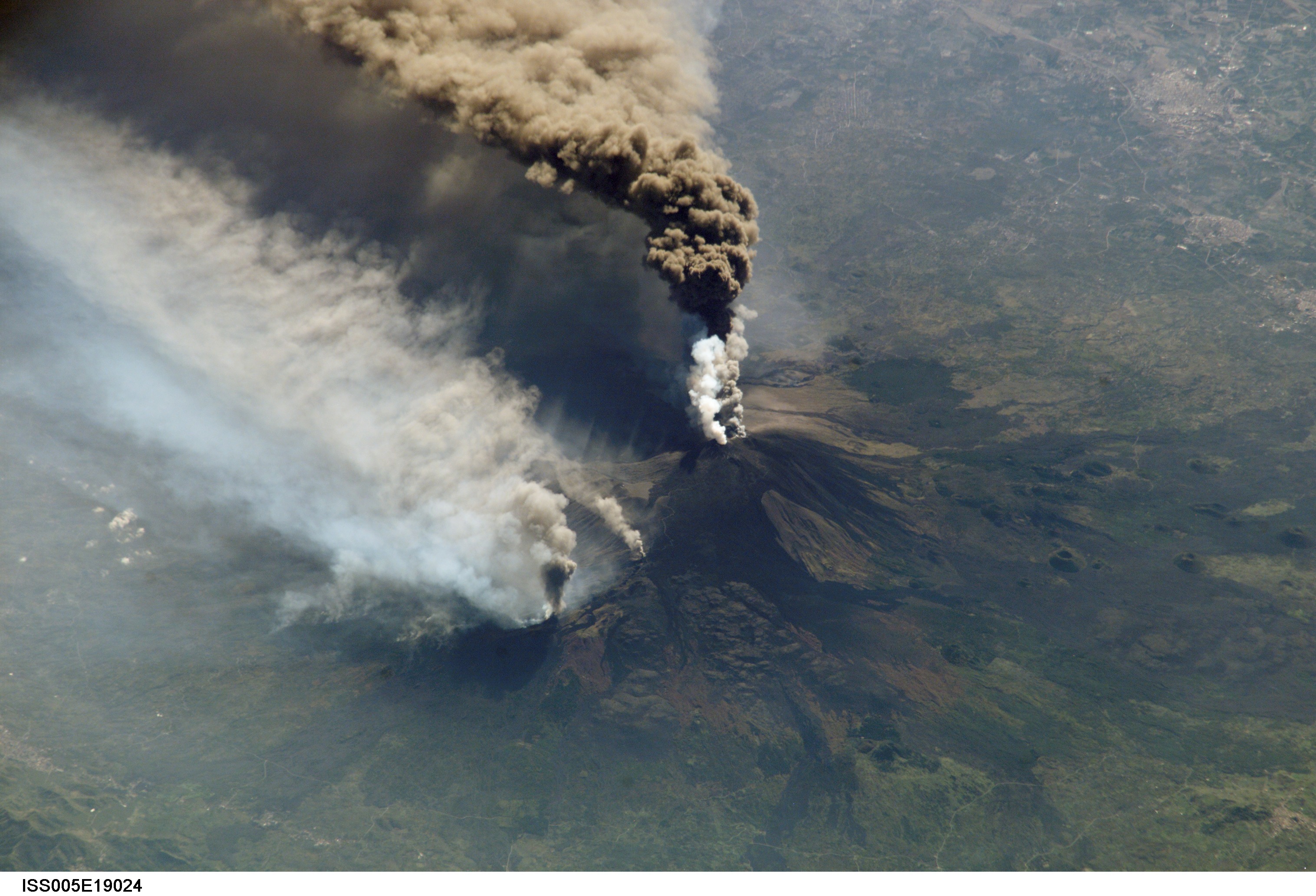
Can Volcanic Super Eruptions Lead to Major Cooling? Study Suggests No
New research suggests that sunlight-blocking particles from an extreme eruption would not cool surface temperatures on Earth as severely as previously estimated.

PACE Mission’s Sujung Go: Helping Humanity and the Environment
Research scientist Sujung Go analyzes atmospheric data to help humanity and the environment. Name: Sujung Go Title: Research scientist Organization: Climate and Radiation Laboratory, Earth Sciences Division, Science Directorate (Code 613) What do you do and what is most interesting about your role here at Goddard? I work in the team of Dr. Alexei Lyapustin […]
Discover More Topics From NASA
Explore Earth Science

Earth Science in Action

Earth Science Data

Facts About Earth

Air travel smells worse than ever. Here's how to fix it.
Air travel stinks.
You don't have to tell that to Danielle Belyeu, who was recently stuck next to a passenger with strong body odor – rotting cheese and onion, as she described it – on a flight from the Caribbean island of Curaçao to Miami.
"Thank goodness the flight was only a couple of hours," said Belyeu, a travel advisor from Summerville, South Carolina.
Check out Elliott Confidential , the newsletter the travel industry doesn't want you to read. Each issue is filled with breaking news, deep insights, and exclusive strategies for becoming a better traveler. But don't tell anyone!
Being a travel pro, she came prepared: A lightly scented spray bottle of hand sanitizer held the stench at bay during the flight.
There's a war of scents going on at 36,000 feet, and it's escalating in ways you can't see (but will probably smell). Some passengers are treating personal hygiene as if it's optional. Others are taking matters into their own hands by spraying unapproved scents. Airlines, meanwhile, are maintaining a double standard for smells.
Pay less to fly: New strategies for finding cheap airfares now
What are airline policies for smells?
It turns out airlines have rules about smells, but they're problematic.
For example:
- American Airlines' contract of carriage , the legal agreement between you and the airline, says it can refuse to transport "persons who have an offensive odor such as from a draining wound."
- Delta Air Lines also reserves the right to refuse transportation "when the passenger’s conduct, attire, hygiene or odor creates an unreasonable risk of offense or annoyance to other passengers."
- United Airlines has a similar provision , refusing to carry "Passengers who have or cause a malodorous condition."
At the same time, airlines have given themselves a broad license to release their scents on the plane.
A few years ago, United reportedly began using a proprietary fragrance called Landing (orange peel, bergamot, cypress) in its cabins. Delta Air Lines perfumed its planes with Calm (lavender and chamomile). During the pandemic, airlines sprayed the cabin interiors with chemical cleaners that left some passengers with a headache. And don't even get me started on the lungfuls of jet fuel fumes that sometimes waft through the cabin before takeoff.
Like I said, it's a war of scents up there.
Why airline passengers are holding their noses
Reports of smelly aircraft have been in the news lately. There was that allegedly flatulent passenger on an American Airlines flight from Phoenix to Austin. One witness claimed it became so unbearable that the flight turned around and headed back to the gate to remove the malodorous traveler.
Last year, two Air Canada passengers were removed from a flight because they reportedly wouldn't sit in vomit-covered seats. The airline later apologized.
Many of the smells come from the cargo hold. One frequent offender is durian fruit, with its distinctive odor of honey, sewage and rotting onion. It has forced several planes to make emergency landings. Many airlines ban durian fruit despite its popularity in Asia.
My worst odor experience happened many years ago when I flew from New York to Vienna on a Soviet-made aircraft operated by the Romanian flag carrier Tarom.
I was stuck in the back of the plane, and the moment the "no smoking" lights went out, it seemed like every passenger – including the kids – lit up at the same time. But that wasn't the only problem. The bathrooms were directly behind me, and someone had poured a chemical that smelled like cherry and battery acid into the toilets, which started to overflow within an hour of departure.
It was a long flight.
How to fight against the smells without breaking the rules
So what should you do if you encounter a bad smell on a plane? Before you go spraying perfumes and air fresheners – which your airline might not allow – here are a few less invasive strategies.
Say something. Find someone who can help you. A flight attendant might be able to move you to a different seat or, if the flight hasn't left yet, remove the offending smeller. "Politely tell the attendants right away," said Jackson Groves, a frequent air traveler and adventure travel blogger. "Working together, I'm sure they can fix it or make it more bearable."
Address the problem — politely. If the problem is a person, you may be able to negotiate a truce. "One person’s dream scent is another person’s nightmare," said etiquette expert Nick Leighton. If you see someone spraying cologne on the seat, you may want to remind them that it's polite to remain odor-neutral.
Improvise. That's what Uneaka Daniels, a reading specialist from Bermuda, does when she's sitting next to a passenger with body odor issues. She carries a white scarf with diffusing beads that contain essential oils. Technically, she's not spraying anything. She used that strategy on a recent flight to London. "The guy next to me did not smell pleasant, and it was a six-hour flight," she remembered.
And don't be part of the problem. If you think you might create a smell on the plane, refrain from any activity that might stink the cabin up. That includes eating a big Italian dinner with extra garlic, a Polish sausage, and durian. Definitely, avoid durian.
"And please do not wear perfume when you know you will board an airplane," added manners expert Adeodata Czink. "It bothers the people seated around you, and they can't leave the plane."
But is there a way to defuse this smell-a-palooza? Maybe.
How to fix the air travel smells
There's a way to call a truce in the odor war on planes, but it will require some leadership from the airline industry.
It starts with creating a common-sense standard for flights and holding everyone to them. The Canadian Centre for Occupational Health and Safety offers some suggestions for creating a scent-free policy.
That means asking passengers to attend to their personal hygiene and refrain from using perfume and cologne before the flight. An airline might also issue a formal policy limiting scented products on the plane. Things like smelly aftershave, essential oils, lotions and soaps would be verboten.
Most importantly, airlines need to hold themselves to the same standard they set for passengers. In other words, no industrial cleaners in the bathroom and no signature scents called "calm," "happy," or "I want to sign up for your addictive loyalty program."
Scents are a serious problem on planes. Strong body odors can literally make you vomit. Chemicals in scented products can create headaches, nausea, upper respiratory problems, and skin irritation.
It's time for the scent war to end on the plane. Wait until you land to slather on the Chanel Bleu or douse yourself in lavender oil.
Your fellow passengers thank you in advance – and so do I.
Christopher Elliott is an author, consumer advocate, and journalist. He founded Elliott Advocacy , a nonprofit organization that helps solve consumer problems. He publishes Elliott Confidential , a travel newsletter, and the Elliott Report , a news site about customer service. If you need help with a consumer problem, you can reach him here or email him at [email protected] .
Air travel smells worse than ever. Here’s how to fix it
Travel troubleshooter.
Air travel stinks.
You don’t have to tell that to Danielle Belyeu, who recently was stuck next to a passenger with a strong body odor on a flight from the Caribbean island of Curaçao to Miami.
“Thank goodness the flight was only a couple of hours,” says Belyeu, a travel adviser from Summerville, S.C.
Being a travel pro, she came prepared: A lightly scented spray bottle of hand sanitizer held the stench at bay during the flight.
There’s a war of scents going on at 36,000 feet, and it’s escalating in ways you can’t see (but will probably smell). Some passengers are treating personal hygiene as if it’s optional. Others are taking matters into their own hands by spraying unapproved scents. Airlines, meanwhile, are maintaining a double standard for smells.
What are airline policies for smells?
It turns out airlines have rules about smells, but they’re problematic.
For example:
- American Airlines’ contract of carriage , the legal agreement between you and the airline, says it can refuse to transport “persons who have an offensive odor such as from a draining wound.”
- Delta Air Lines also reserves the right to refuse transportation “when the passenger’s conduct, attire, hygiene or odor creates an unreasonable risk of offense or annoyance to other passengers.”
- United Airlines has a similar provision , refusing to carry “Passengers who have or cause a malodorous condition.”
At the same time, airlines have given themselves a broad license to release their scents on the plane.
A few years ago, United reportedly began using a proprietary fragrance called Landing (orange peel, bergamot, cypress) in its cabins. Delta Air Lines perfumed its planes with Calm (lavender and camomile). During the pandemic, airlines sprayed the cabin interiors with chemical cleaners that left some passengers with a headache. And don’t even get me started on the lungfuls of jet fuel fumes that sometimes waft through the cabin before takeoff.
Like I said, it’s a war of scents up there.
Why airline passengers are holding their noses
Reports of smelly aircraft have been in the news lately. There was that flatulent passenger on an American Airlines flight from Phoenix to Austin, Texas. One witness said it became so unbearable that the flight turned around and headed back to the gate to remove the malodorous traveler.
Last year, two Air Canada passengers were removed from a flight because they reportedly wouldn’t sit in vomit-covered seats. The airline later apologized.
Many of the smells come from the cargo hold. One frequent offender is durian fruit, with its distinctive odor of honey, sewage and rotting onion. It has forced several planes to make emergency landings. Many airlines ban durian fruit despite its popularity in Asia.
My worst odor experience happened many years ago when I flew from New York to Vienna on a Soviet-made aircraft operated by the Romanian flag carrier Tarom.
I was stuck in the back of the plane, and the moment the “no smoking” lights went out, it seemed like every passenger — including the kids — lit up at the same time. But that wasn’t the only problem. The bathrooms were directly behind me, and someone had poured a chemical that smelled like cherry and battery acid into the toilets, which started to overflow within an hour of departure.
It was a long flight.
How to fight against the smells without breaking the rules
So what should you do if you encounter a bad smell on a plane? Before you go spraying perfumes and air fresheners — which your airline might not allow — here are a few less invasive strategies.
Say something. Find someone who can help you. A flight attendant might be able to move you to a different seat or, if the flight hasn’t left yet, remove the offending smeller. “Politely tell the attendants right away,” says Jackson Groves, a frequent air traveler and adventure travel blogger. “Working together, I’m sure they can fix it or make it more bearable.”
Address the problem — politely. If the problem is a person, you may be able to negotiate a truce. “One person’s dream scent is another person’s nightmare,” says etiquette expert Nick Leighton. If you see someone spraying cologne on the seat, you may want to remind them that it’s polite to remain odor-neutral.
Improvise. That’s what Uneaka Daniels, a reading specialist from Bermuda, does when she’s sitting next to a passenger with body odor issues. She carries a white scarf with diffusing beads that contain essential oils. Technically, she’s not spraying anything. She used that strategy on a recent flight to London. “The guy next to me did not smell pleasant, and it was a six-hour flight,” she remembers.
And don’t be part of the problem. If you think you might create a smell on the plane, refrain from any activity that might stink the cabin up. That includes eating a big Italian dinner with extra garlic, Polish sausage and durian. Definitely avoid durian.
“And please do not wear perfume when you know you will board an airplane,” adds manners expert Adeodata Czink. “It bothers the people seated around you, and they can’t leave the plane.”
But is there a way to defuse this smell-a-palooza? Maybe.
How to fix the air travel smells
There’s a way to call a truce in the odor war on planes, but it will require some leadership from the airline industry.
It starts with creating a commonsense standard for flights and holding everyone to them. The Canadian Centre for Occupational Health and Safety offers some suggestions for creating a scent-free policy.
That means asking passengers to attend to their personal hygiene and refrain from using perfume and cologne before the flight. An airline might also issue a formal policy limiting scented products on the plane. Things like smelly aftershave, essential oils, lotions and soaps would be verboten.
Most Read Life Stories
- These ‘Marry Me’ white beans make for a quick, tasty snack
- Why Ballard dive bars thrive in changing Seattle
- 11 great Ballard restaurants, bars and deals, named by our critic
- James Beard winner Renee Erickson on Ballard’s role in restaurant empire
- What makes Ballard cool? A debate for the decades
Most important, airlines need to hold themselves to the same standard they set for passengers. In other words, no industrial cleaners in the bathroom and no signature scents called “calm,” “happy” or “I want to sign up for your addictive loyalty program.”
Scents are a serious problem on planes. Strong body odors can literally make you vomit. Chemicals in scented products can create headaches, nausea, upper respiratory problems, and skin irritation.
It’s time for the scent war to end on the plane. Wait until you land to slather on the Chanel Bleu or douse yourself in lavender oil.
Your fellow passengers thank you in advance — and so do I.
The opinions expressed in reader comments are those of the author only and do not reflect the opinions of The Seattle Times.
- EO Explorer

- Global Maps
Aerosols: Tiny Particles, Big Impact
Take a deep breath. Even if the air looks clear, it’s nearly certain that you’ll inhale tens of millions of solid particles and liquid droplets. These ubiquitous specks of matter are known as aerosols, and they can be found in the air over oceans, deserts, mountains, forests, ice, and every ecosystem in between. They drift in Earth’s atmosphere from the stratosphere to the surface and range in size from a few nanometers—less than the width of the smallest viruses—to several several tens of micrometers—about the diameter of human hair. Despite their small size, they have major impacts on our climate and our health.

Aerosols—tiny, airborne solid & liquid particles—are present throughout the atmosphere and largely responsible for hazy skies, as in this photograph of Shenzen, China. (Photograph ©2010 pseudo-san. )
Different specialists describe the particles based on shape, size, and chemical composition. Toxicologists refer to aerosols as ultrafine, fine, or coarse matter. Regulatory agencies, as well as meteorologists, typically call them particulate matter—PM 2.5 or PM 10 , depending on their size. In some fields of engineering, they’re called nanoparticles. The media often uses everyday terms that hint at aerosol sources, such as smoke, ash, and soot.
Climatologists typically use another set of labels that speak to the chemical composition. Key aerosol groups include sulfates, organic carbon, black carbon, nitrates, mineral dust, and sea salt. In practice, many of these terms are imperfect, as aerosols often clump together to form complex mixtures. It’s common, for example, for particles of black carbon from soot or smoke to mix with nitrates and sulfates, or to coat the surfaces of dust, creating hybrid particles.

Sea salt, dust, and volcanic ash are three common types of aerosols. (Photograph by Katherine Mann. )
The bulk of aerosols—about 90 percent by mass—have natural origins. Volcanoes, for example, eject huge columns of ash into the air, as well as sulfur dioxide and other gases, yielding sulfates. Forest fires send partially burned organic carbon aloft. Certain plants produce gases that react with other substances in the air to yield aerosols, such as the “smoke” in the Great Smoky Mountains of the United States. Likewise in the ocean, some types of microalgae produce a sulfurous gas called dimethylsulfide that can be converted into sulfates in the atmosphere.
Sea salt and dust are two of the most abundant aerosols, as sandstorms whip small pieces of mineral dust from deserts into the atmosphere and wind-driven spray from ocean waves flings sea salt aloft. Both tend to be larger particles than their human-made counterparts.

These scanning electron microscope images (not at the same scale) show the wide variety of aerosol shapes. From left to right: volcanic ash, pollen, sea salt, and soot. [Micrographs courtesy USGS, UMBC (Chere Petty), and Arizona State University (Peter Buseck).]
The remaining 10 percent of aerosols are considered anthropogenic, or human-made, and they come from a variety of sources. Though less abundant than natural forms, anthropogenic aerosols can dominate the air downwind of urban and industrial areas.
Fossil fuel combustion produces large amounts of sulfur dioxide, which reacts with water vapor and other gases in the atmosphere to create sulfate aerosols. Biomass burning, a common method of clearing land and consuming farm waste, yields smoke that’s comprised mainly of organic carbon and black carbon.

Desert dust, volatile organic compounds from vegetation, smoke from forest fires, and volcanic ash are natural sources of aerosols. (Photographs copyright (left to right) Western Sahara Project, Jonathan Jessup, Vox, and Ludie Cochrane. )
Automobiles, incinerators, smelters, and power plants are prolific producers of sulfates, nitrates, black carbon, and other particles. Deforestation, overgrazing, drought, and excessive irrigation can alter the land surface, increasing the rate at which dust aerosols enter the atmosphere. Even indoors, cigarettes, cooking stoves, fireplaces, and candles are sources of aerosols.
When viewed from space, a number of patterns emerge from Earth’s aerosols—some driven by nature and others by man.
Nature generates broad swaths of particles—detectable by satellites—over both water and land. The strong winds of the “roaring forties” latitudes, for example, create a heavy band of airborne salt north of Antarctica. A thinner and more evenly dispersed veil of aerosols—primarily salt from whitecaps and sulfates from microalgae—usually covers most of the world’s oceans. Over land, massive plumes of dust blow above deserts.
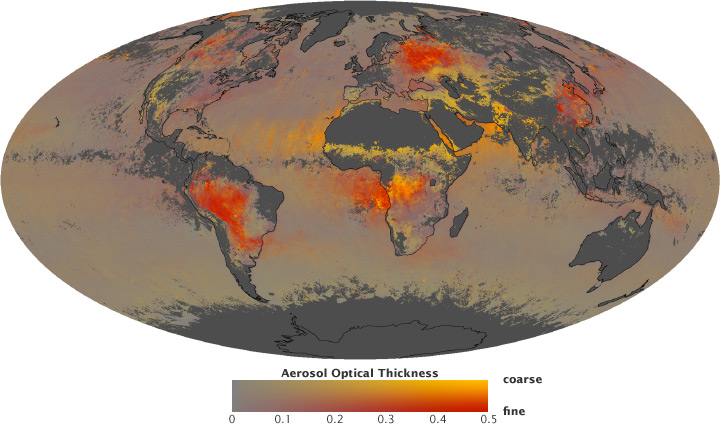
This map shows the global distribution of aerosols and the proportion of those aerosols that are large or small. Intense colors indicate a thick layer of aerosols. Yellow areas are predominantly coarse particles, like dust, and red areas are mainly fine aerosols, like smoke or pollution. Gray indicates areas with no data. (NASA map by Robert Simmon, based on MODIS data from NASA Earth Observations. )
Meanwhile, the eastern portion of the United States and urban areas in Europe are hotspots for the production of human-made aerosols. Plumes of industrial aerosols — typically sulfates from coal power plants and black and organic carbon from vehicle traffic — rise from cities such as New York, Pittsburgh, London, and Berlin.
The western portion of the United States is comparatively clear, though some areas experience aerosol loads that rival the worst conditions in the East. Industrial aerosols, dust, and wildfire smoke frequently pollute the air in the Los Angeles Basin. Agriculture can produce heavy loads of soil dust, especially in California’s San Joaquin and Imperial valleys, and the largest localized source of dust in the western U.S. is Owens Dry Lake, a river bed that was drained to provide water for LA. Likewise, the port of Houston has some of the most aerosol-laden air in the world.
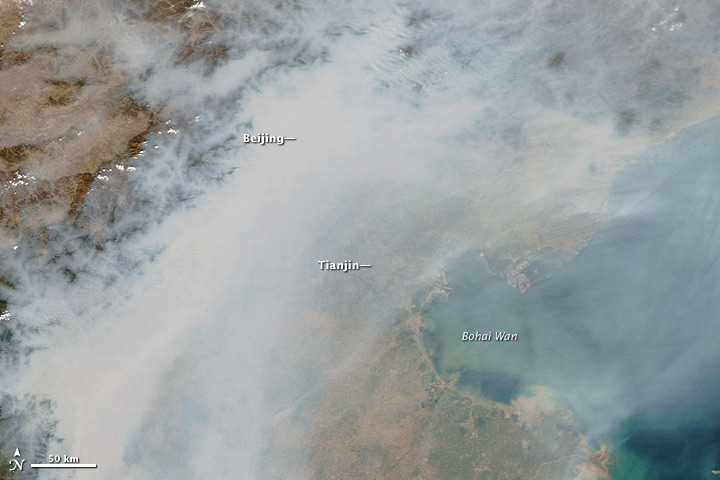
Beijing was completely obscured by air pollution on October 9, 2010. This natural-color image was acquired by MODIS aboard the Aqua satellite. (NASA image by Jeff Schmaltz, MODIS Rapid Response. )
However, the most aerosol-laden air in the United States today pales in comparison to Asia. Satellites can detect a visible pall of aerosol clouds over Bangladesh, northern India, and northern Pakistan—an area called the Indo-Gangetic plain, especially during the pre-Monsoon season. The aerosol layer is comprised of complex mixtures of dust blowing from the Thar Desert and pollution from the densely populated plain. In eastern China, fast-growing cities such as Beijing also produce heavy blankets of aerosol.
Depending on the season and weather conditions, surges of aerosols can make their way into the atmosphere almost anywhere on Earth. In the Northern Hemisphere, plumes of mineral dust swirl over deserts and arid regions. In the Southern Hemisphere, slash-and-burn agriculture in the Amazon and Central Africa releases large amounts of smoke and soot. Fires, some sparked by lightning and some by human activity, leave large patches of forest ablaze during summers in Canada, Russia, and the United States.
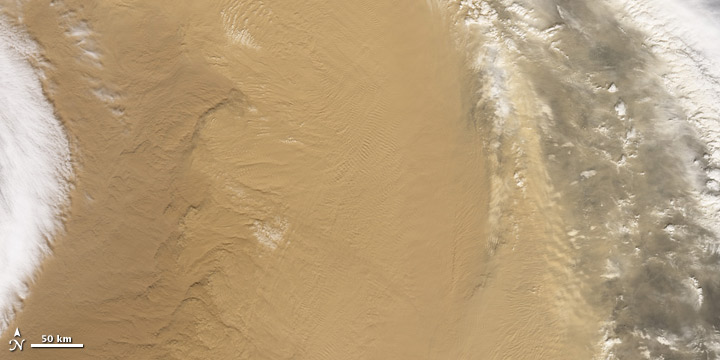
Dust storms (top) and wildfires (bottom) are significant, if transient, sources of aerosols. (NASA images by Jeff Schmaltz, MODIS Rapid Response. )
Although most aerosols remain suspended in the atmosphere for short periods—typically between four days and a week—they can travel vast distances. Particles moving with the atmosphere at 5 meters (16.4 feet) per second will travel thousands of kilometers in a week. Dust plumes from the Sahara frequently cross the Atlantic and reach the Caribbean. Winds sweep a mixture of Asian aerosols—particularly dust from the Gobi desert and pollution from China—east over Japan and toward the central Pacific Ocean. Smoke from wildfires in Siberia and Canada can find its way to the Arctic ice cap.

Dust from North Africa spreads over the Atlantic Ocean on July 1, 2009 (from 00:00 to 18:00 Universal Time) in this series of images derived from a computer model of aerosol movement. Click for animation. (NASA maps by Pete Colarco and Robert Simmon, based on GEOS-5 model data.)
Over time, aerosol emissions have changed significantly. In Asia, anthropogenic emissions have increased in recent decades as urbanization and industrialization has proceeded at a breakneck pace. By contrast, aerosols have declined in North America and Europe as factories have moved to developing countries and Western nations have adopted more stringent clean air regulations.
Aerosols and Incoming Sunlight (Direct Effects)
The Sun provides the energy that drives Earth’s climate, but not all of the energy that reaches the top of the atmosphere finds its way to the surface. That’s because aerosols—and clouds seeded by them—reflect about a quarter of the Sun’s energy back to space.
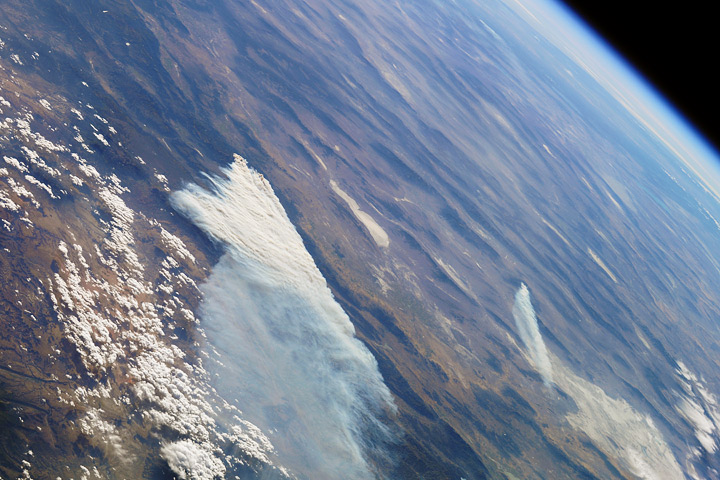
Aerosols play an important role in Earth’s climate. Most aerosols are brighter than land or ocean, and cool the Earth by reflecting sunlight back to space. (NASA astronaut photograph ISS024-E-15122. )
Different aerosols scatter or absorb sunlight to varying degrees, depending on their physical properties. Climatologists describe these scattering and absorbing properties as the “direct effect” of aerosols on Earth’s radiation field. However, since aerosols comprise such a broad collection of particles with different properties, the overall effect is anything but simple.
Although most aerosols reflect sunlight, some also absorb it. An aerosol’s effect on light depends primarily on the composition and color of the particles. Broadly speaking, bright-colored or translucent particles tend to reflect radiation in all directions and back towards space. Darker aerosols can absorb significant amounts of light.
Pure sulfates and nitrates reflect nearly all radiation they encounter, cooling the atmosphere. Black carbon, in contrast, absorbs radiation readily, warming the atmosphere but also shading the surface. Organic carbon, sometimes called brown carbon or organic matter, has a warming influence on the atmosphere depending on the brightness of the underlying ground. Dust impacts radiation to varying degrees, depending on the composition of the minerals that comprise the dust grains, and whether they are coated with black or brown carbon. Salt particles tend to reflect all the sunlight they encounter.
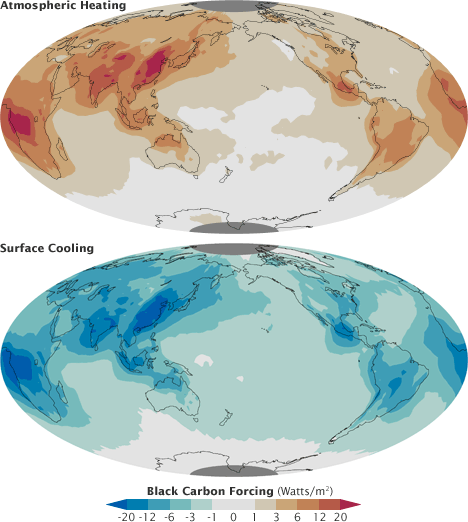
Black carbon aerosols, similar to the soot in a chimney, absorb sunlight rather than reflecting it. This warms the layer of the atmosphere carrying the black carbon, but also shades and cools the surface below. (Maps adapted from Chung, 2005. )
Aerosols can have a major impact on climate when they scatter light. In 1991, the eruption of Mount Pinatubo in the Philippines ejected more than 20 million tons of sulfur dioxide—a gas that reacts with other substances to produce sulfate aerosol—as high as 60 kilometers (37 miles) above the surface, creating particles in the stratosphere. Those bright particles remained above the clouds and didn’t get washed from the sky by rain; they settled only after several years.
Climatologists predicted global temperatures would drop as a result of that global sulfate infusion. They were right: Following the eruption, global temperatures abruptly dipped by about a half-degree (0.6°C) for about two years. And Pinatubo isn’t a unique event. Large, temperature-altering eruptions occur about once per decade.

Large volcanic eruptions may lift sulfate aerosols into the stratosphere, which usually cools the global climate for the following year or two. (Graph by Robert Simmon, based on aerosol data from GISS and temperature data from the UAE CRU.)
In addition to scattering or absorbing radiation, aerosols can alter the reflectivity, or albedo, of the planet. Bright surfaces reflect radiation and cool the climate, whereas darker surfaces absorb radiation and produce a warming effect. White sheets of sea ice, for example, reflect a great deal of radiation, whereas darker surfaces, such as the ocean, tend to absorb solar radiation and have a net warming effect.
Aerosols, particularly black carbon, can alter reflectivity by depositing a layer of dark residue on ice and other bright surfaces. In the Arctic especially, aerosols from wildfires and industrial pollution are likely hastening the melting of ice.
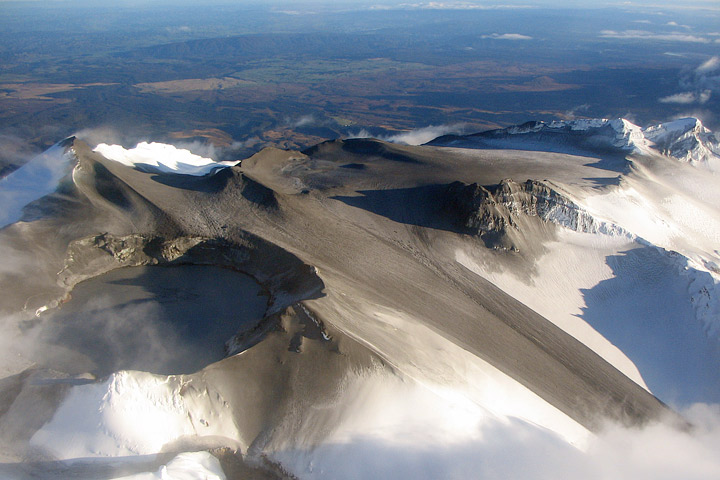
Dark aerosols dramatically change the reflectivity of the Earth’s surface when they land on snow. Black ash covered the summit of New Zealand’s Mount Ruapehu after an eruption in 2007, but was soon covered by fresh snow. Long-term accumulation of black carbon aerosols in the Arctic and Himalaya is leading to increased melting of snow. ( Photograph ©2007, New Zealand GeoNet. )
Scientists believe the cooling from sulfates and other reflective aerosols overwhelms the warming effect of black carbon and other absorbing aerosols over the planet. Models estimate that aerosols have had a cooling effect that has counteracted about half of the warming caused by the build-up of greenhouse gases since the 1880s. However, unlike many greenhouse gases, aerosols are not distributed evenly around the planet, so their impacts are most strongly felt on a regional scale.
Despite considerable advances in recent decades, estimating the direct climate impacts of aerosols remains an immature science. Of the 25 climate models considered by the Fourth Intergovernmental Panel on Climate Change (IPCC), only a handful considered the direct effects of aerosol types other than sulfates.
Aerosols and Clouds (Indirect Effects)
Whereas aerosols can influence climate by scattering light and changing Earth’s reflectivity, they can also alter the climate via clouds. On a global scale, these aerosol “indirect effects” typically work in opposition to greenhouse gases and cause cooling. While greenhouse gases disperse widely and have a fairly consistent impact from region to region, aerosol effects are less consistent, partly because of how the particles affect clouds.
Most elementary school students learn that clouds form when enough water vapor condenses. That’s true, but aerosols play a critical role in the process. In fact, most clouds owe their existence to aerosols that serve as the tiny “seeds,” called cloud condensation nuclei.
Natural aerosols—often sulfates, sea salt or ammonium salts—are the most common condensation nuclei in pristine environments. Polluted air, in contrast, usually contains much higher concentrations of water-soluble particles, which means pollution-rich clouds tend to have more numerous, but smaller, droplets. The small droplets make polluted clouds look brighter than they would otherwise be. Just as many bits of crushed ice give light more surfaces to reflect off—appearing brighter than a solid cube of ice—if the water in a cloud is divided into a larger number of smaller droplets, it will scatter more light and become more reflective.
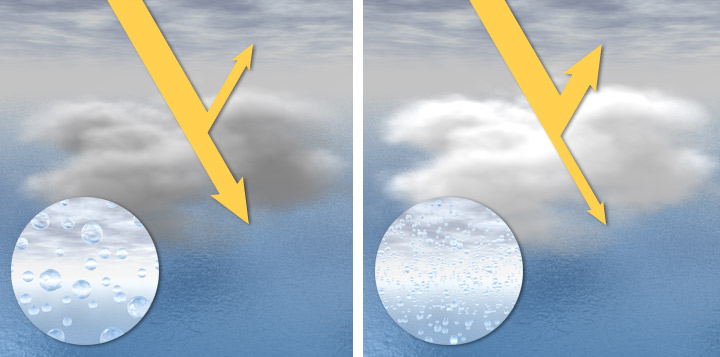
Clouds in clean air are composed of a relatively small number of large droplets (left). As a consequence, the clouds are somewhat dark and translucent. In air with high concentrations of aerosols, water can easily condense on the particles, creating a large number of small droplets (right). These clouds are dense, very reflective, and bright white. This influence of aerosols on clouds is called the “indirect effect,” and is a large source of uncertainty in projections of climate change. (NASA image by Robert Simmon.)
Brighter clouds, in turn, block sunlight from reaching Earth’s surface, shading the planet and producing net cooling. This cloud brightening effect—called the “cloud albedo effect”—may have a big impact on the climate, though only in recent years has it been possible to start quantifying the effect.
This impact of aerosols is clearly visible in ship tracks, bright streaks in marine clouds that look like airplane contrails. In the absence of ships, sea salt particles and the natural sulfates produced by phytoplankton seed most marine clouds. However, the exhaust from ship smokestacks make trails of sulfates and other aerosols that form long, bright clouds.
Overall, clouds are thought to cool Earth’s surface by shading about 60 percent of the planet at any one time and by increasing the reflectivity of the atmosphere. Given that, just a 5 percent increase in cloud reflectivity could compensate for the entire increase in greenhouse gases from the modern industrial era in the global average. Likewise, long-term decreases in cloudiness could have major impacts.
However, aerosols are distributed around the planet differently than greenhouse gases, so the effects do not simply cancel each other. Parsing out how clouds—as well as feedback cycles involving clouds—affect regional climate systems remains a high priority for climatologists.

The effect of aerosols on clouds is clearly visible in ship tracks—the dense, bright marine clouds formed by the exhaust of passing ships. This natural-color image shows the bright white clouds (top) and a map of cloud droplet radius (bottom). Where ship exhaust mixed with the cloud layer, droplets became much smaller. (NASA image by Jesse Allen and Robert Simmon, based on data from MODIS. )
Aerosols also have complex effects on clouds and precipitation. Broadly speaking, aerosols are thought to suppress precipitation because the particles decrease the size of water droplets in clouds. However, under some environmental conditions, aerosols can lead to taller clouds that are more likely to produce lightning and strong downpours. In a few places, meteorologists have even detected a cycle in which the frequency of thunderstorms is connected to mid-week peaks in aerosol emissions.
Aerosol type plays an important role in determining how aerosols affect clouds. Whereas reflective aerosols tend to brighten clouds and make them last longer, the black carbon from soot can have the opposite effect. Studies of pollution over the Indian Ocean and biomass burning smoke in the Amazon have shown that the black carbon warms the surrounding atmosphere and can cause cloud droplets to evaporate. This process, called the “semi-direct effect,” turns clouds into a smoky haze that suppresses precipitation.
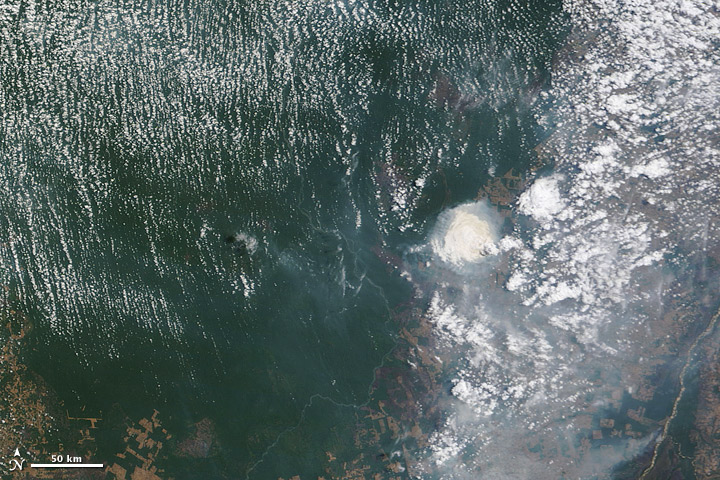
Interactions between smoke and clouds are complex. In some cases, smoke and other aerosols help cloud formation. In others, smoke suppresses clouds. Both effects are apparent in this natural-color satellite image of the Brazilian Amazon, acquired on August 31, 2010. (NASA image by Jeff Schmaltz, MODIS Rapid Response. )
Current estimates suggest the cooling driven by aerosol indirect effects is less than half as much as the warming caused by greenhouse gases when averaged over the globe. But these indirect effects are highly uncertain and vary considerably in space and time. Therefore, on smaller space and time scales, the climate effects of aerosols can be significant.
The details of aerosol indirect effects are only partially understood, as most instruments cannot measure aerosols within clouds. Climatologists consider the role of clouds to be the largest single uncertainty in climate prediction. Less than a third of the models participating in the Fourth Intergovernmental Panel on Climate Change (IPCC) included indirect aerosol effects, even in a very limited way, and those considered only sulfate aerosols.
Measuring Aerosols
Although it became clear about 40 years ago that aerosols could affect climate, the measurements needed to establish the magnitude of such effects—or even whether specific aerosol types warm or cool the surface—were lacking.
The situation has improved considerably. Today scientists use an array of satellite, aircraft, and ground-based instruments to monitor aerosols. Radiometers—instruments that quantify the amount of electromagnetic radiation (light)—are among the most important tools available. The key quantity they report is aerosol optical depth (AOD), a measure of the amount of light that aerosols scatter and absorb in the atmosphere (and generally prevent from reaching the surface). An optical depth of less than 0.05 indicates a clear sky with relatively few aerosols and maximum visibility, whereas a value of 1 indicates hazy conditions. Optical depths above 2 or 3 represent very high concentrations of aerosols.

Aerosol optical depth is the fundamental measurement of quantity and distribution of aerosols. This map shows the average distribution of aerosols from June 2000 through May 2010, measured by the Multi-angle Imaging Spectroradiometer (MISR). Red indicates high concentrations of aerosols, beige indicates low concentrations. (NASA map by Robert Simmon, based on MISR data.)
Aerosol monitoring instruments also measure single scattering albedo (SSA), the fraction of light that is scattered compared to the total. Values for most aerosols range from about 0.7 for very absorbing particles to 1 for aerosols that only scatter light.
The first satellite instrument capable of crudely monitoring aerosol optical depth from space—the Advanced Very High Resolution Radiometer (AVHRR)—retrieved optical depth from measurements in the visible and near-infrared spectrum, beginning in the late 1970s. AVHRR, a passive radiometer, measured the intensity of sunlight as it reflected off aerosols, using the dark ocean as the background.
Over subsequent decades, the instruments have grown more sophisticated and made it possible to study aerosols over the land as well. Newer radiometers such as the Multi-angle Imaging Spectroadiometer (MISR) and the Moderate Resolution Imaging Spectroradiomer (MODIS) are capable of viewing aerosols at many more angles and wavelengths, providing more accurate results.
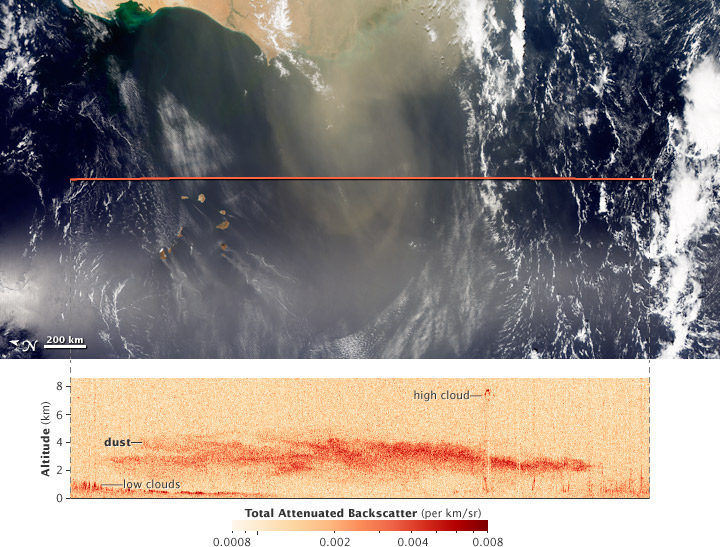
Satellite instruments such as CALIPSO can measure the distribution of aerosols in a vertical slice of the atmosphere. This image shows a dust plume off the west coast of Africa on April 22, 2010. (NASA image by Jesse Allen and Robert Simmon, based on data from MODIS and CALIPSO. )
Newer instruments also provide insight into properties of light that AVHRR couldn’t detect. The Cloud Aerosol Lidar and Infrared Pathfinder Satellite Observer (CALIPSO) uses a laser-based technology that provides detailed vertical profiles of aerosol plumes and clouds. A French instrument, the Polarization and Directionality of the Earth’s Reflectances (POLDER) offers insight into the orientation—or polarization—of light waves as they move through the atmosphere. This previously unmeasured quantity has proven helpful in retrieving particle type information. An instrument even more sensitive to the polarization of light, the Aerosol Polarimetery Sensor (APS), will gather additional insights after its launch aboard NASA’s Glory mission in 2011.

Starting in 2011, the Glory mission will enable scientists to better characterize the types and distribution of aerosols. (NASA image by Ryan Zuber, GSFC Scientific Visualization Studio. )
Satellites provide a critical global perspective for understanding how aerosols affect Earth’s climate, but they are far from the only source of information. Networks of ground-based sensors are used to validate satellite measurements and offer some of the most accurate measurements of AOD available.
NASA co-sponsors a global network of ground sensors called the Aerosols Robotic Network, or AERONET, which is comprised of more than 200 carefully calibrated sun photometers measuring aerosol optical depth around the world. The relatively simple instruments deduce the amount and type of aerosol in the sky by measuring the intensity of light under cloud-free conditions. Aircraft and other ground stations deploy in situ instruments that measure certain aerosol properties with greater accuracy, but less frequently.

Land-based and airborne instruments complement NASA’s satellites. AERONET is a global network of sun photometers that measures aerosols from the ground, such as this station in the Canadian Arctic (top). The Global Hawk Uninhabited Aerial Vehicle (bottom) can carry several instruments to measure aerosols from the air. Photograph by Ovidiu Pancrati, ©2007 CANDAC. Lower photograph by Tony Landis/NASA.)
Despite great progress, many questions remain about the competing impacts of aerosols. Measuring particles within clouds remains challenging. Different types of particles can clump together to form hybrids that are difficult to distinguish. And changes in humidity or temperature can cause drastic changes in how certain aerosols behave and interact with cloud droplets.
Most importantly, the quantitative uncertainties in the amount of aerosols, and especially aerosol properties, need to be reduced. Only better measurements—and the more sophisticated computer modeling such measurements make possible—will provide the critical information that scientists need to fully integrate aerosol impacts into climate models and to reduce uncertainty about how the climate will change.
- Chin, M., Diehl, T. Ginoux, P. and Malm, W. (2007). Intercontinental transport of pollution and dust aerosols: implications for regional air quality. Atmospheric Chemistry and Physics, 7, 5501-5517.
- Chin, M., Kahn, R., and Schwartz, S. (2009). Atmospheric Aerosol Properties and Climate Impacts: A Report by the U.S. Climate Change Science Program and the Subcommittee on Global Change Research. Washington, DC: NASA.
- Chung, C., Ramanathan, V., Kim, D., and Podgomy, I. (2005). Global anthropogenic aerosol direct forcing derived from satellite and ground-based observations. Journal of Geophysical Research. 110, D24207.
- Holben, B., Tanré, D., Smirnov, A., et al. (2001). An emerging ground-based aerosol climatology: aerosol optical depth from AERONET. Journal of Geophysical Research, VOL. 106, NO. D11, PP. 12,067-12,097.
- Kaufman, Y., Tanré, D., and Boucher, O. (2002). A satellite view of aerosols in the climate system. Nature, 419, 215-223.
- Koren, I., Kaufman, Y., Remer, L., and Martins, J. (2004). Measurement of the effect of Amazon smoke on inhibition of cloud formation. Science, 303, 1342.
- Levin, Z. and Cotton, W.R. (2008). Aerosol pollution impact on precipitation: A scientific review. Report from the WMO/IUGG International Aerosol Precipitation Science, Assessment Group (IAPSAG). Geneva, Switzerland: World Meteorological Organization.
- Mishchenko, M., et al., (2007). Long-term satellite record reveals likely recent aerosol trend. Science, 315, 1543.
- Remer, L., et al., (2008). An emerging aerosol climatology from the MODIS satellite sensors. Journal of Geophysical Research, 113, D14S01.
- Seinfeld, J. (2008). Atmospheric science: Black carbon and brown clouds. Nature Geoscience, 1, 15–16.
- Solomon, S., D. Qin, M. Manning, Z. Chen, M. Marquis, K.B. Averyt, M. Tignor and H.L. Miller, (eds.). (2007). Climate Change 2007: The Physical Science Basis. Cambridge, United Kingdom and New York, NY, USA: Cambridge University Press.
- Unger, N., Bond, T., Wang, J., Koch, D., Menon, S., Shindell, D., and Bauer, S. (2010). Attribution of climate forcing to economic sectors. Proceedings of the National Academy of Sciences, 107, 3382-3387.
Atmosphere Human Presence
Goddard Earth Sciences Division Projects
Aerosols and their importance, what are aerosols.
Aerosols are small particles suspended in the atmosphere. They are often not or barely visible to the human eye, yet their impact on climate, weather, health, and ecology are significant. This page introduces the various major types of aerosols, and explains why researching them is important.
Aerosols range in size from a few tens of nanometers—less than the width of the smallest viruses—to several tens of micrometers—about the diameter of human hair. The size and composition of aerosol particles affects how far they can travel around the world, their interactions with solar and thermal radiation, and their potential effects on health. Aerosols injected into the atmosphere directly are known as 'primary aerosols'. Sea spray, mineral dust, smoke, and volcanic ash are all primary aerosols. Secondary aerosols are aerosols which were emitted in another form (e.g. gases), then become aerosol particles after going through chemical reactions in the atmosphere, such as sulfate aerosols from volcanoes or industrial emissions. All aerosols can also undergo further chemical changes, referred to as ‘aging effects’. Some more information about these various aerosol types is given below.
Mineral Dust
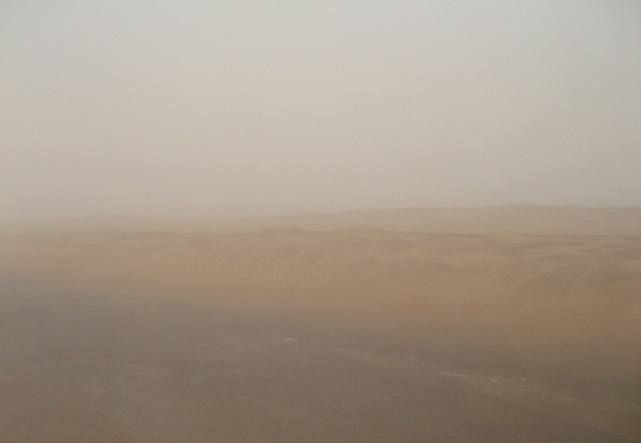
Mineral dust is emitted when wind blows over deserts or otherwise dry soils, lifting the particles get carried off into the atmosphere. Mineral dust is one of the most abundant aerosol types, and dust particles are also very large compared to other aerosols, often a size of several micrometers in diameter. One micrometer is 0.000001 meters.
Approximately two billion metric tons of mineral dust are emitted per year, with wide-ranging effects. For example, mineral dust from the Sahara can affect the formation of hurricanes in the Atlantic , and fertilize the Amazon basin . Some desert source regions of mineral dust include the Sahara, Sahel, Gobi, Taklamakan, Namib, Salar de Uyun, central Australia, and the United States’ Great Basin. Dust can also be emitted from dry, barren soils, which can be exacerbated by deforestation and overgrazing. North African dust storms occur year-round, while Asian dust storms are most frequent during the spring. The satellite images below show two dust storms on quite difference scales.
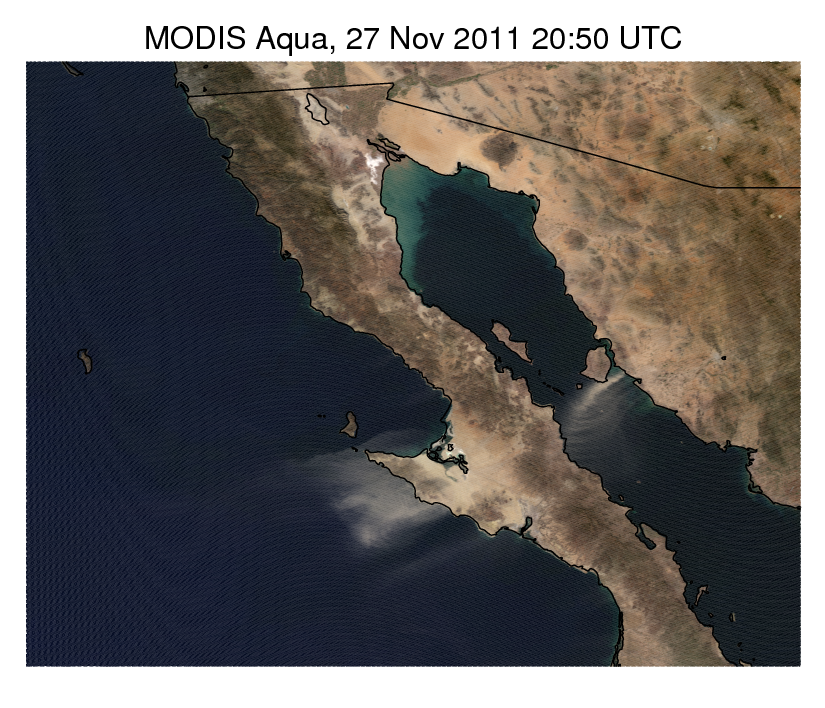
Sea spray is largely composed of sea salt, but also consists of organic matter such as dissolved organic carbon, or even bacteria, phytoplankton, and microalgae. It is commonly formed through the bursting of air bubbles over the ocean surface. The properties of sea spray are chiefly dependent on wind speed, near-surface relative humidity, and sea surface temperature .

Smoke is emitted from fires, both natural wildfires and human-caused (for e.g. agricultural practices such as land clearing and waste incineration). These are often also referred to as 'biomass burning' aerosols, and are composed of organic (brown) and black carbon (soot) . The composition of smoke is strongly dependent on the fuel source burning, and atmospheric conditions (e.g. moisture) at the time.
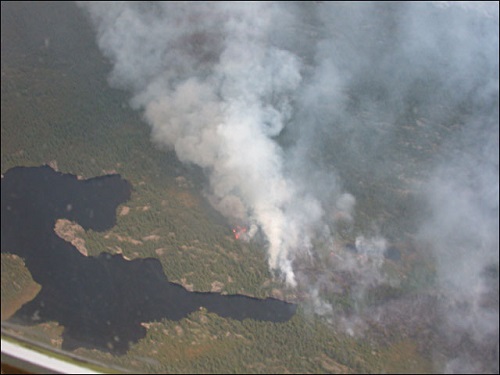
Organic and black carbon absorb light to varying extents, which warms the atmosphere locally while simultaneously shading and cooling the surface below. When black carbon is deposited on snow and ice, it decreases their reflectivity of those surfaces, which can warm them and speed up their melting. Short-term and long-term exposure to black carbon can result in visibility impairment, respiratory and cardiovascular effects, and even premature death .
Industrial aerosols
Since the start of the Industrial Revolution, the amount of aerosols emitted by human activities has increased greatly. These industrial aerosols may have a wide variety of compositions. Some industrial aerosols include:
- Sulfates, which are produced when sulfur dioxide (SO 2 ) reacts with water vapor and other gases in the atmosphere. One source of this is the burning of coal and oil.
- Nitrates, which are often formed when combustion engines (such as vehicles or power plants) release nitrogen oxides (NO x ).
- Organic and black carbon, again also from combustion.
Together, this combination can be responsible for a visible smog, and heavy exposure can have harmful effects to plant and animal life, although air quality regulations have improved the situation in recent years over some parts of the world. For example, cities such as London and Los Angeles used to be infamous for their smog, although conditions in these cities have improved greatly. However, air quality in many other parts of the world is still a concern.
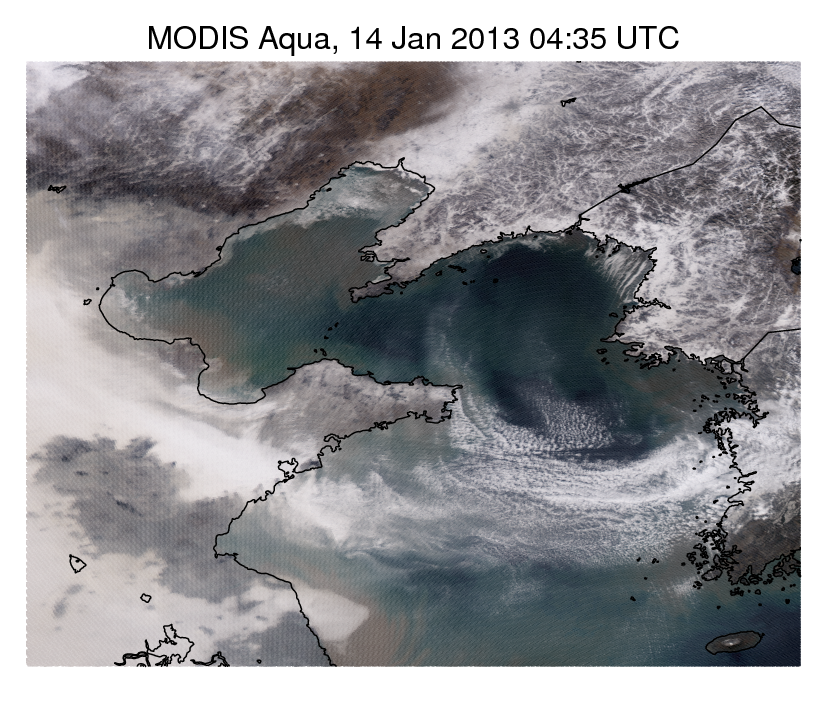
Volcanic aerosols
Volcanoes produce two main aerosols: ash and sulfate. Ash is a dark, large aerosol produced by the pulverization of crystallized magma and contains minerals such as silica and feldspar. The ash clouds can have significant impacts on human health and safety. They pose a significant threat to air traffic, as ash can destroy the engines of planes. Ash deposits, if thick enough, can damage buildings. Volcanic ash also irritates the lungs, and can cause acute respiratory damage or even death if enough is inhaled.
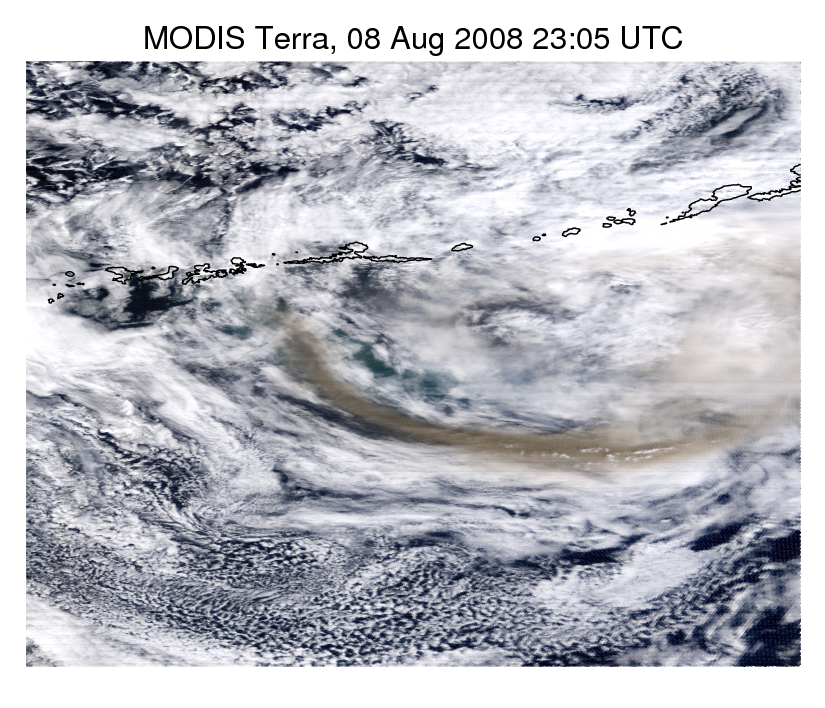
Through eruptions and during passive degassing, volcanoes emit SO 2 , which is oxidized in the atmosphere to sulfate aerosols. Large eruptions can cause widespread cooling as a result of these sulfate aerosols. For instance, Pinatubo injected 20 million tons of SO2 into the stratosphere, causing an abrupt half-degree (0.6°C) drop in global temperatures. This lasted two years, ending as sufate finally dropped out of the atmosphere. Volcanic ash is also rich in nutrients, such as iron, that are used by ocean-dwelling organisms such as phytoplankton. An eruption therefore can be a natural fertilizer for areas of the ocean with insufficient levels of iron, such as the northeast Pacific. This area experienced a large phytoplankton bloom shortly after the eruption of the volcano Kasatochi in the Aleutian Islands in 2008.

Biogenic aerosols
Not all aerosols fall into the above categories. Biogenic aerosols are those which come from living things. This can include organic chemicals such as limonene, which are emitted by plants and react in the atmosphere to form aerosols, as well as other debris such as pollen, spores, and microbes.
Aerosol transport and lifetime
Aerosol lifetimes range from hours to years, dependent primarily on the size of the particles and the height at which they are injected into the atmosphere. For fine aerosols injected near the surface, the lifetime is typically several days. This increases to weeks or months for particles injected into or transported to the upper troposphere, and fine aerosols in the stratosphere (e.g. volcanic sulfate) can remain there for years. Because of these short lifetimes, many therefore are not usually transported far from their sources. For example, the highest concentrations of organic carbon, black carbon, and nitrate aerosols are found over North America, Europe, and East Asia, which are also the most prolific producers of industrial emissions. However, there are many examples of long range transport, such as:
- Saharan desert dust crossing the the Atlantic to Central and South America.
- Transport of mineral dust and industrial aerosols across the Pacific from China to North America .
- Travel of wildfire smoke across the Northern Hemisphere .
- Injection of SO 2 into the stratosphere from strong volcanic eruptions, such as the 1991 Mt. Pinatubo eruption, which is then converted to sulfate aerosols that can remain in the atmosphere for years and form a global aerosol layer.
Aerosols are removed from the atmosphere by either "dry" or "wet" processes:
- Dry removal is when particles are deposited on the surface by turbulence or gravity. Movement of small particles is dominated by Brownian motion (random movement), while heavy particles feel the effects of gravitational settling.
- Wet removal processes occur when the aerosol is removed in precipitation (water, fog or ice). Aerosol particles may be rained out by collision with falling raindrops ('inertial removal', most effective for heavy particles), or through diffusion of aerosols into falling drops (most efficient for very small particles). The total aerosol amount removed through wet processes does, of course, depend on how much moisture there is. Large aerosol particles are able to act as cloud condensation nuclei (CCN), meaning cloud droplets form by condensing on the aerosol particles. Clouds can form and rain within an hour, and the raindrops remove both the aerosols they formed on and any caught by wet removal processes. Wet removal processes are illustrated below:
Why are we interested in aerosols?
There are many reasons why we study and monitor aerosol levels. Some of these are discussed below.
Radiation Effects
Aerosols scatter (reflect) a portion of the Sun's incoming light, and, dependent on type, may also absorb some. These are known as 'direct radiative effects' of aerosols. The scattering has a local cooling effect on the surface below, while absorption has a local warming effect on the atmosphere where the aerosols are located. Sometimes these effects can be large and more widespread. For example, when the volcano Pinatubo erupted in 1991, so many reflective sulfate aerosols were released into the stratosphere that the temperature dropped around 0.6°C .

Another set of effects are known as 'indirect effects' or 'aerosol-cloud interactions'. Aerosols are largely responsible for the creation of clouds by acting as cloud condensation 'nuclei, or a sort of foundation for clouds to accumulate water on. Increasing the amount of aerosols in the atmosphere can influence factors such as how many clouds there are, how large the cloud droplets are, how high the clouds are, and when or how heavy rainfall is. These are known as 'indirect radiative effects' of aerosols. You can watch a video about these indirect effects from volcanic sulfate aerosols on YouTube here . There is also a `semi-direct effect' whereby local heating of the atmosphere by absorbing aerosols like black carbon can influence whether clouds form at all, or lead to the evaporation of existing clouds.

One well-known manifestation of aerosol effects on clouds is seen in ship tracks, where aerosols emitted from ship exhaust lead to a decrease in cloud particle size, causing a bright streak of cloud to follow the ship.
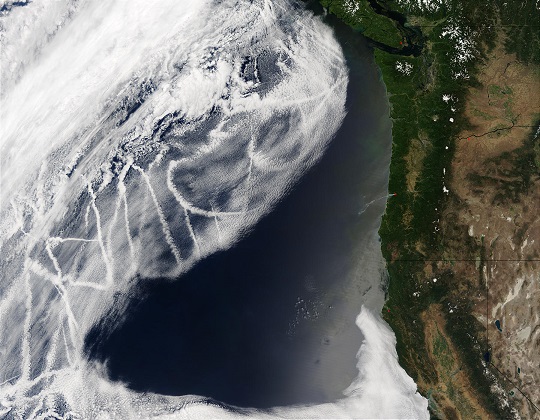
When absorbing aerosols such as soot or dust are deposited on snow or ice, they decrease its reflectivity ('albedo') and cause the surface to absorb more light, which has a warming effect. This can lead to, for example, faster retreat of glaciers .

Aerosols have the capacity to cause damage to plants and animals, including humans. Aerosol particles can irritate the lungs, and in high enough concentrations cause permanent respiratory damage and even death . Chronic exposure to fine particulate matter is associated with adverse health impacts such as decreased life expectancy and higher likelihoods of lung cancer. Fine particulate air pollution has also been determined to have adverse effects on cardiovascular health.
Mineral dust can be blown across and between continents by the wind. For example, about half of the dust arriving at the Amazon rainforest, which fertilizes plant growth, comes from the Bodele Depression in the Sahara Desert. Nutrients from dust deposited in the oceans can also lead to algal blooms, as seen below.

Mineral dust can also transport bacteria and viruses living within it. For example, the shrinking of the Aral Sea since the second half of the 20th century has led to health problems for those living in the region.
Solar Power

The efficiency of solar power generation systems is affected by aerosols . Aerosol scattering and absorption reduces the amount of direct sunlight reaching solar panels, by about 4 W for every watt reflected to outer space , decreasing their potential yield.
Go to the top
This page was prepared by A. Chen, B. Howl, and A. Sidel during their summer 2015 internship with the Deep Blue group at NASA GSFC.
More From Forbes
Global travel: which countries are least polluted, per new study.
- Share to Facebook
- Share to Twitter
- Share to Linkedin
San Juan in Puerto Rico is one of the best cities globally for low air pollution, as per the 2023 ... [+] survey on air quality
It's not often that we think of how polluted somewhere is when we plan our travels—but data in the 2023 World Air Quality report by IQAir reveals that the air quality of some common holiday destinations might make us rethink.
There isn't much research that investigates the impact on travelers' health in visiting places that are heavily polluted. A 2021 study found that there were adverse health impacts of air pollution exposure on international travellers, and although these were thought to be reversible upon returning home, there were calls for more research on vulnerable populations. Another study in 2019 found that travel-related exposure to air pollution in healthy adults had led to statistically significant changes in respiratory health.
The map shows that while much of the U.S. and Europe has better air quality than other parts of the world, many of the cities across these land masses exceed WHO air quality levels by one or two times. Indeed, this is true for 124 of the 134 countries and regions with available data.
The PM2.5 concentration was measured—meaning fine particulate aerosol particles measuring up to 2.5 microns in diameter—as the primary air quality indicator for this study. These could be dust mite allergens or bacterium that emanate from sulfates, black carbon, nitrates, and ammonium. These can come from man-made sources like coal and wood burning, agricultural activities, and construction, as well as from natural sources such as dust storms, wildfires, and sandstorms. As a comparison, pollen and dust would be much bigger than these particles (10 microns).
These concentrations are measured in micrograms per cubic meter (μg/m³) and are one of many environmental indicators measured by environmental agencies to monitor pollution, and the WHO says that PM2.5 concentrations should not exceed 5 micrograms per cubic metre.
In One Massive Attack, Ukrainian Missiles Hit Four Russian Ships—Including Three Landing Vessels
A mel gibson thriller never released in us theaters is trending on netflix, why raising retirement age for social security means cutting benefits.
In Europe, some of the cleanest air, reports The Telegraph can be found in Iceland, which was beaten only by the quality of the air in Mauritius and French Polynesia. Estonia, Finland and Sweden also had higher air quality than other countries. The U.K. came in tenth place.
In Europe, Bosnia and Herzegovina has the worst air quality, on a par with Uganda and Senegal. Crucially too, many European holiday hotspots came quite high on the list of countries with poor air quality, places like Turkey, Albania ( a favorite 2024 destination ) and Greece.
In the U.K., there were only four places that meet the WHO guidelines of 5 micrograms or less per cubic metre—Newton Abbot in South Devon, Redcar in North Yorkshire, Stape in North Yorkshire and Chirk in Wales. Scotland fares better, with Edinburgh (4.9), Motherwell (4.1) and Inverness (4.5) among those making the cut.
Further afield, New Zealand and Australia fare well (sixth and seventh spot for cleanest air respectively) but Asia houses 97 of the 100 most polluted cities on Earth with 83 located in India. As an idea, the most polluted city (for air pollution) is Begusarai, on the Ganges river in northeast India with an average annual PM2.5 reading of 118.9 µg/m3.
There were seven global cities with the best air quality—that within the WHO zone —with San Juan in Puerto Rico (2.7) coming in first place, followed by Wellington in New Zealand, Canberra in Australia, and Reykjavik in Iceland (3.4). Hamilton in Bermuda, Tallinn in Estonia and Helsinki in Finland round out the list. Only 6.7% of European cities, though, meet the WHO guidelines.
After two years of war, Ukraine reported decreasing air quality due to military vehicle and aircraft emissions and the need to use solid fuel sources to heat homes.
In the U.S., 14% of U.S. cities meet the WHO requirements but the Canadian wildfires that burnt an area roughly half the size of Germany from May to October 2023 radically reduced the air quality. As a result, the report states that in some cities, "including Minneapolis and Detroit, annual averages rose by 30 to 50% compared to the previous year." The most polluted major city in the U.S. was Columbus, Ohio, for the second year in a row.
It's good news for travelers to Wyoming, Colorado, Arizona and New Mexico as these states experienced the lowest PM2.5 levels in the continental United States, with Tucson, Arizona (3.5 µg/m3 ) and Albuquerque, New Mexico (4 µg/m3 ) both reporting annual averages that meet the WHO guideline levels.
There are many things travelers can do to lower their own personal air pollution footprint, notably bike, walk, or use public transport where possible, as well as reducing their energy consumption.
Many countries could not be included in the report although these also tend to be places that have lower levels of tourism, such as Chad, Sudan and Iran, where there is a lack of publicly available monitoring data.
Data is gathered in 134 regions and countries using 30,000 ground-level air monitoring stations, as well as low-cost air quality sensors operated by institutions, governmental bodies, universities, non-profits, private companies, and citizen scientists.

- Editorial Standards
- Reprints & Permissions
Algae, Aerosols, and Asthma | Ohio Sea Grant
We see you are using an outdated browser. Be secure and please upgrade your browser to improve your experience.
[ ☰ ] Ohio State University
The Ohio State University
Ohio Sea Grant
/news/2024/dyttn/algae-aerosols-asthma
- Search Ohio State
- Partnerships
- Recognition
- Latest News
- Making Sense of It
- Issues Facing Lake Erie
- REU Program
- Collaborations
- Extension Educators
- Communications
- Science Field Trips
- Virtual Field Trips
- Publications
- Fact Sheets
- Plan a trip
- Gibraltar Island
- South Bass Lighthouse
- Cooke Castle
- Conferences
- Register your visit
- Give a Gift
- Become a Friend
- Student Spotlights
Algae, Aerosols, and Asthma
12:00 pm, Tue March 26, 2024 – Ohio Sea Grant researchers recently made a breakthrough in understanding the risks of breathing in "aerosolized" algal toxins, finding evidence that airway exposure to the algal toxin microcystin can create an inflammatory response in lungs
When harmful algal blooms arise on Lake Erie each summer, people generally know that it’s not safe to ingest water affected by algae. What’s less known, however, are the health risks involved when people breathe in air containing algal toxins.
Ohio Sea Grant researchers recently made a breakthrough in understanding these risks. Drs. Steven Haller and David Kennedy, associate professors at The University of Toledo College of Medicine and Life Sciences, found evidence that airway exposure to the algal toxin microcystin can create an inflammatory response in lungs that is exacerbated in experimental models of asthma.
Bivek Timalsina, Ph.D. candidate at The University of Toledo College of Medicine and Life Sciences, stands next to specialized aerosol equipment used to study the health effects of breathing in algal toxins.
Now, researchers are working with healthcare providers, public health officials, and Ohio residents to share their findings and answer questions.
“It’s gratifying to equip healthcare providers with this information so that they can use evidence-based medicine to help patients who may be at-risk for these types of exposures,” Kennedy said.
The research, funded through the Ohio Department of Higher Education’s Harmful Algal Bloom Research Initiative, looked at aerosols — small particles or droplets suspended in the air — that form through freshwater waves breaking. These “lake spray” aerosols can travel over 19 miles from their original source, and studies have shown that they can carry cyanotoxins from algal blooms. Natural wave motion and, notably, recreational activity can form these tiny bubbles.
“If you’re out on a boat or a jet ski and you’re just stirring up the water, that can also generate aerosols,” said Haller, who served as lead researcher for the project. “Up to this point, the main concern has just been the ingestion of contaminated water, so this is definitely an emerging area.”
When Haller and Kennedy learned about aerosols forming on the Great Lakes, pre-existing asthma came to mind. Asthma — a chronic condition that inflames and narrows airways in the lungs — affects 235 million people globally, and rates of asthma are particularly high in Toledo and other Great Lakes cities.
“That led us to ask, what happens? How are these aerosols affecting the lungs?” Haller said. “If you have asthma, are you even more prone to some of those effects?”
To investigate this, Haller and Kennedy conducted experiments on both experimental animal models and human cells to see how they respond to exposure to aerosolized microcystin-LR (MC-LR), one of the most abundant and potent algal toxins. Human airway tissue cells were sourced from both healthy and asthmatic volunteers who consented to biopsies.
Researchers used a special system to nebulize — turn into an aerosol — algal toxins and distribute them on the surface of the cells, which are grown to replicate the lining of cells in the lungs. This allowed for the exposure to be very controlled and defined, Kennedy said.
“Using donated human lung cells provides a tremendous advantage to our research,” Kennedy said. “They exhibit a lot of the same characteristics that you would see in real life. We try to get as close as possible to what would happen if you or I were out and exposed to these aerosols. How would they respond?”
Associate Professors David Kennedy, left, and Steven Haller work to share comprehensive insights into the prevention, diagnosis, and treatment of health issues associated with harmful algal bloom toxins
While the human cells were only exposed to microcystin for three minutes every three days, researchers were surprised to see a significant inflammatory response in healthy cells. They saw a similar inflammatory response in healthy mice exposed to aerosolized MC-LR as well.
“We started with a very brief exposure and were not really expecting to see anything until we got to longer exposures,” Kennedy said. “But even after that short exposure in healthy cells, we saw a really significant response. That was one of the most eye-opening findings.”
Haller and Kennedy found that the response to the toxin — what genes were produced and how cells behaved — was very much like an asthma response. What’s more, asthmatic cells exposed to the toxin saw an exacerbated inflammatory response. This suggests that patients with pre-existing asthma may be particularly vulnerable to adverse health effects from contaminated aerosols.
While results largely showed injury to the lungs, Haller noted that his team observed increases in inflammation in downstream organs such as the liver and kidneys as well.
“In terms of the quality of the data, we are very excited about it because this is something that had not been reported in the literature,” Kennedy said. “There were almost no studies that actually looked at how human cells respond to microcystin aerosols, in part because the equipment you need is very specialized. So we were very fortunate to procure equipment that allows us to model real-world aerosol exposure.”
Moving forward, Haller and Kennedy plan to share the results with other researchers so it can be confirmed and expanded. Broadly, their team is working to share comprehensive insights into the prevention, diagnosis, and treatment of health issues associated with harmful algal bloom toxins.
Dr. Steven Haller, right, works with student researchers to study how human cells respond to the potent algal toxin microcystin.
“This is one of the first studies of its kind, so it’s important to foster collaboration and further investigation in this emerging field,” Haller said. “This information will be invaluable, especially considering the limited knowledge surrounding the health effects of aerosolized toxins. Providing this information will empower physicians to better treat their patients and address any potential health concerns.”
This effort has resulted in significant outreach work. The team shares findings with a variety of stakeholders: the Toledo-Lucas County Health Department, the Ohio Department of Health, healthcare providers, local advocacy groups, among others. As the research progresses, findings could inform public health guidelines as well, Kennedy said.
“Locally, every summer, algal blooms are on people’s minds, but healthcare providers often have no clue what they should be looking for,” Kennedy said. “By identifying the tools that we have, the health effects, the at-risk populations, you can start to give that information so that healthcare providers go, ‘This make sense. Here’s what we should look for.’”
Next, the team will continue research in this field by setting up an air sampling station on Lake Erie. With funding from the Ohio Department of Higher Education’s Harmful Algal Bloom Research Initiative and working alongside fellow UToledo researcher Dr. Dragan Isailovic, researchers will be able to collect air coming off the lake and look at the health effects of different airborne algal toxins.
“These studies are really impactful, and we really want to thank Sea Grant and the Ohio Department of Higher Education,” Haller said. “These have just been outstanding funding mechanisms for us to actually do this work. It can’t be understated that, because of this funding, there’s no question that Ohio has the absolute best, most state-of-the-art understanding of this and is driving the conversation.”
For more information about the research, contact Dr. Haller at [email protected] and Dr. Kennedy at [email protected].
Ohio Sea Grant is supported by The Ohio State University College of Food, Agricultural, and Environmental Sciences ( CFAES ) School of Environment and Natural Resources , Ohio State University Extension , and NOAA Sea Grant , a network of 34 Sea Grant programs nation-wide dedicated to the protection and sustainable use of marine and Great Lakes resources. Stone Laboratory is Ohio State’s island campus on Lake Erie and is the research, education, and outreach facility of Ohio Sea Grant and part of CFAES School of Environment and Natural Resources.
END :: View Archives
Total solar eclipse could cause air travel delays: FAA
Air traffic and airports along the eclipse's path may be impacted, the FAA said.
A total solar eclipse set to deliver a stunning display in the sky on April 8 could be trouble for some air travelers and pilots due to possible flight delays, the Federal Aviation Administration warned.
The eclipse -- which will pass over Mexico, the United States and Canada -- is expected to impact air traffic and airports along the eclipse's path from April 7 until April 10, the FAA said in a notice about special air traffic procedures . This could mean delays for air travelers, too -- especially as the eclipse overlaps with spring break travel, the agency said Wednesday.
The FAA estimated that any air travel impacts from the eclipse would be felt from April 7 at 6 a.m. until April 10 at midnight.
"While most travelers are heading to their favorite vacation destinations, a significant number of travelers are heading to various states to witness 'The Great North American Eclipse' on Monday, April 8," the FAA said in a news release.
MORE: Explosive 'devil comet' returns for 1st time in 71 years during April 8 eclipse, NASA says

"Travelers flying along the eclipse path may encounter limited parking and potential delays at airports due to the high volume of aircraft and drones attempting to witness the total solar eclipse," the FAA said.
A total solar eclipse -- which happens when the moon passes between the sun and Earth, completely blocking the face of the sun -- is a draw for many people since it can be rare. The last total solar eclipse that was visible in the U.S. took place in 2017, according to NASA.
Many travelers are planning to fly to the states where the eclipse is expected to be most visible: from Texas to New England, the FAA said. Airports in these states will be most affected, the agency said.
"Some are even planning their flights to be airborne during the actual eclipse," FAA Aviation Safety Expert Kevin Morris said.

Air travel to see the eclipse intersects with spring break travel, which the FAA predicted will make next week "the busiest of the season."
The busiest travel days are expected to be March 28, April 4 and April 5, with more than 50,000 flights expected on several of those days, the FAA said.
The FAA is working to make sure pilots are prepared for the eclipse, too, and are offering guidance to commercial and private pilots that includes anticipating larger-than-normal numbers of aircraft and drones in the area, potential delays and limited parking at some airports.
MORE: Eclipse glasses: What to know to keep your eyes safe
"And remember, never look directly at the sun," Morris added.
It's not safe to look directly at the sun during an eclipse without specialized eye protection for solar viewing, NASA says.
Delays and cancellations are low but can happen, the FAA said, reminding travelers to check the status of their flights and get important travel tips on the FAA website before heading to the airport.
Related Topics
- Solar Eclipse
Top Stories

Bridge collapse live updates: First responders called out to people on bridge

Democrats sound alarm on RFK Jr. and new running mate, Shanahan
- Mar 27, 3:34 PM

Fani Willis vows nothing 'will derail' Trump's election interference trial
- Mar 27, 5:41 PM

RNC won't pay Trump's bills, daughter-in-law says, insisting 2020 is 'in the past'
- Mar 27, 3:27 PM

Trump lawyers to argue for dismissal of Georgia election case based on 1st Amendment
- 3 hours ago
ABC News Live
24/7 coverage of breaking news and live events

Early Adopters of NASA’s PACE Data to Study Air Quality, Ocean Health
From the atmosphere down to the surface of the ocean, data from NASA’s PACE (Plankton, Aerosol, Cloud, ocean Ecosystem) satellite benefits ecosystems, human health, and underrepresented communities.
Years before the launch in February 2024, mission leaders from NASA teamed with dozens of applied scientists and environmental professionals to prepare for the many practical uses that could be informed by PACE data. PACE’s Early Adopter program integrates science data into business, environmental management, and decision-making activities to benefit society.
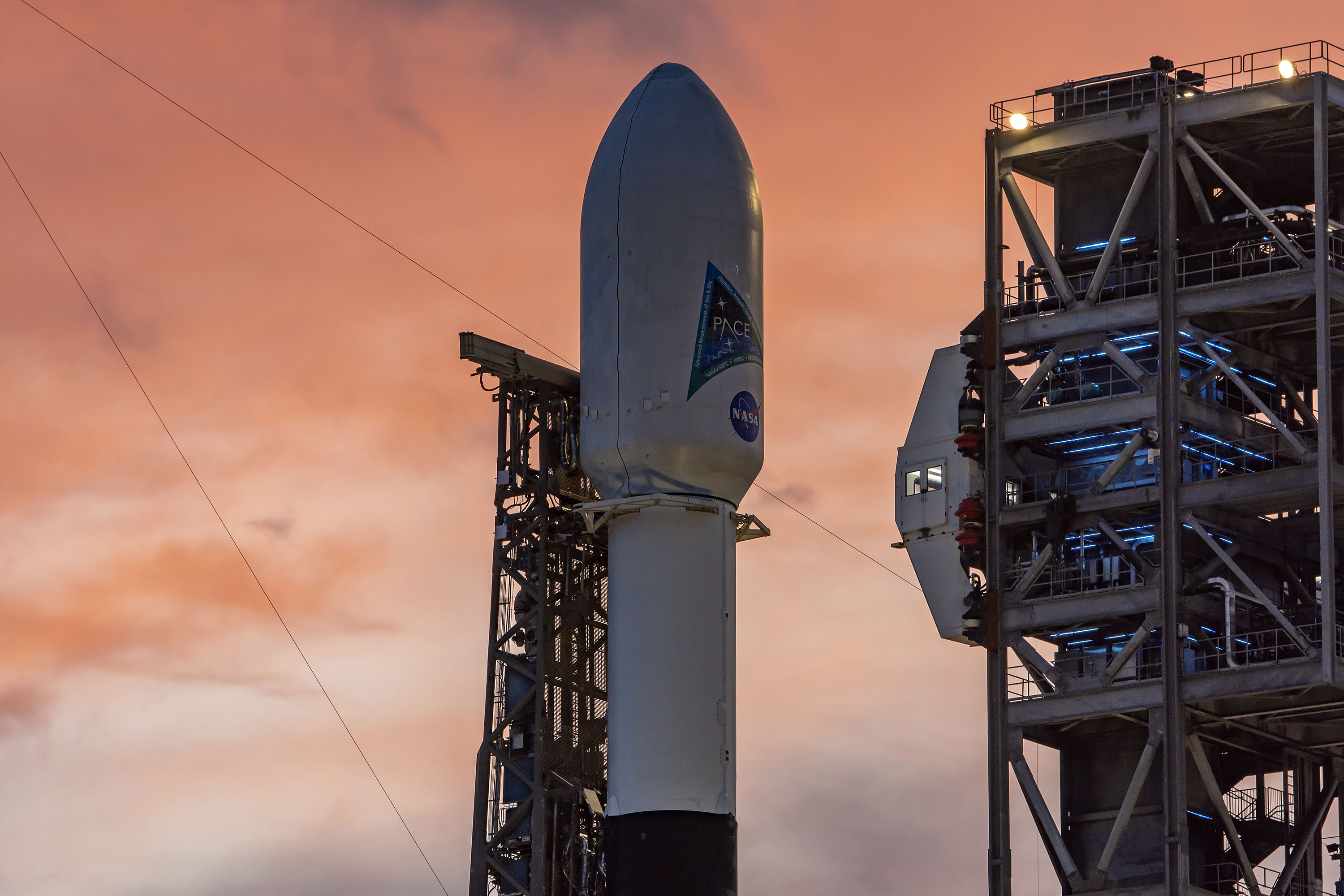
The researchers specialize in a wide range of topics including water resources, fisheries and aquaculture, air quality and health, climate, and agriculture. These early adopters of the science provide a bridge between the PACE team and local communities and decision-makers who need accessible products for public use. Such work can help connect the new frontier of PACE’s hyperspectral and multi-angular polarimetric data to real-world problems – and find new ways to address challenges.
Helping Coastal Communities Keep Fisheries Safe
In coastal communities, knowing the quality of the water is essential for ecosystem health, safe and sustainable seafood, and recreation – not to mention human livelihoods that depend on fisheries.
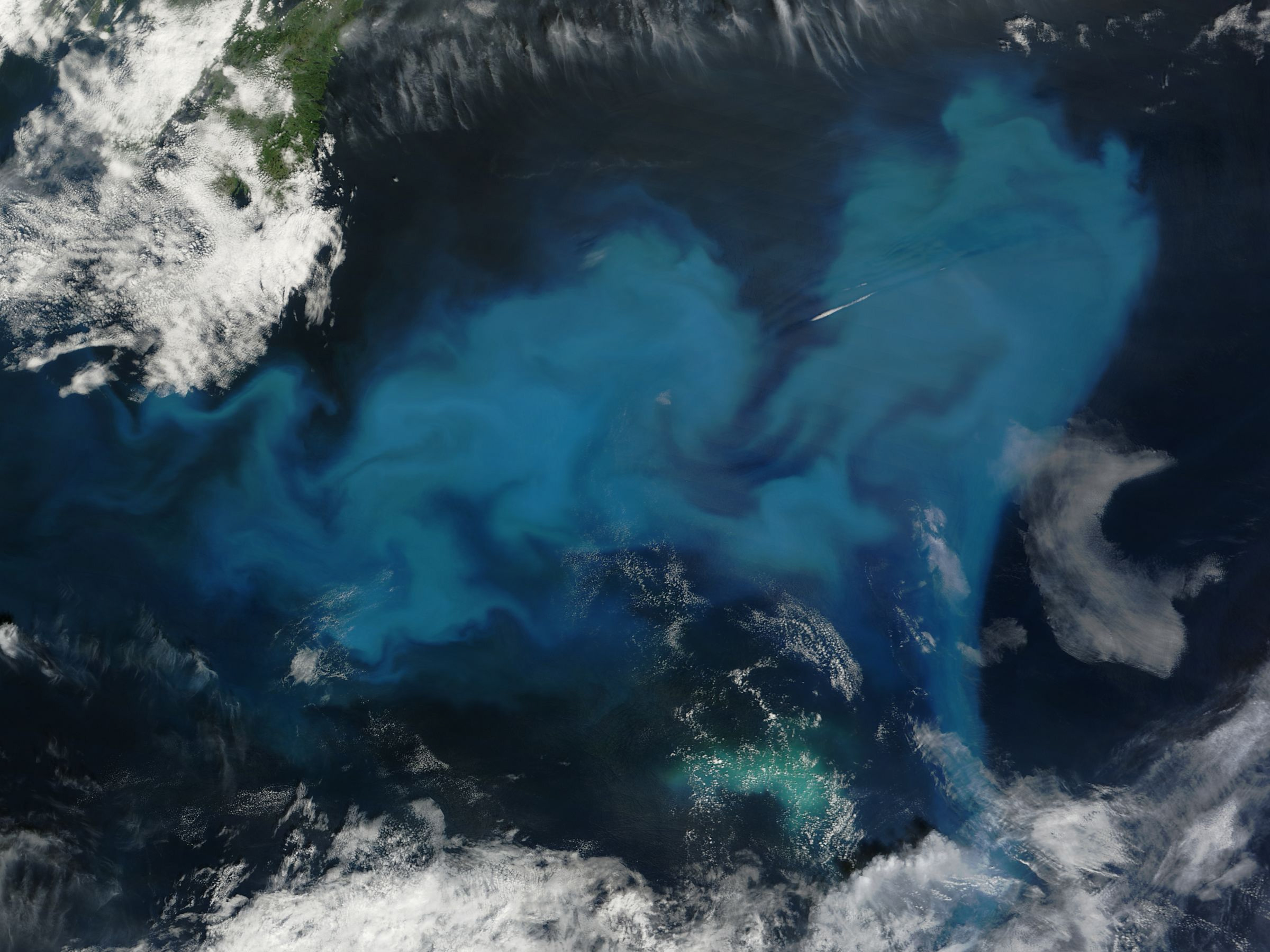
Marina Marrari, executive director of the Costa Rican Fishing Federation in San José is one of PACE’s early adopters. Marrari and her colleagues developed a mobile app that will pull in data from PACE’s Ocean Color Instrument to help inform the public about harmful algal blooms. Known as pezCA, the app distributes near real-time data about ocean temperature, chlorophyll concentration, and currents as measured by other NASA satellites. Once PACE data is available, the app will be updated to include a product on specific types of harmful algal blooms that can have toxic effects on people and animals.
Bringing Air Quality Alerts to the Midwest
Information on air quality and airborne particles (aerosols) is typically available for dense urban areas like Los Angeles, Atlanta, and New York. Marcela Loría-Salazar, assistant professor at the University of Oklahoma in Norman, plans to use data from PACE’s polarimeters and OCI to study air quality in locations in the middle of the United States, where there tend to be fewer ground-based monitors.
Urban pollution emissions, desert dust, and smoke from wildfires can travel from distant places – across continents or even oceans. (Think of the wildfire smoke that can blow from Alaska and Canada into the central U.S.) PACE gathers global data on this dust and smoke in Earth’s atmosphere every one to two days, and that data is open access – meaning it is available for anyone to find and download free from the Internet.
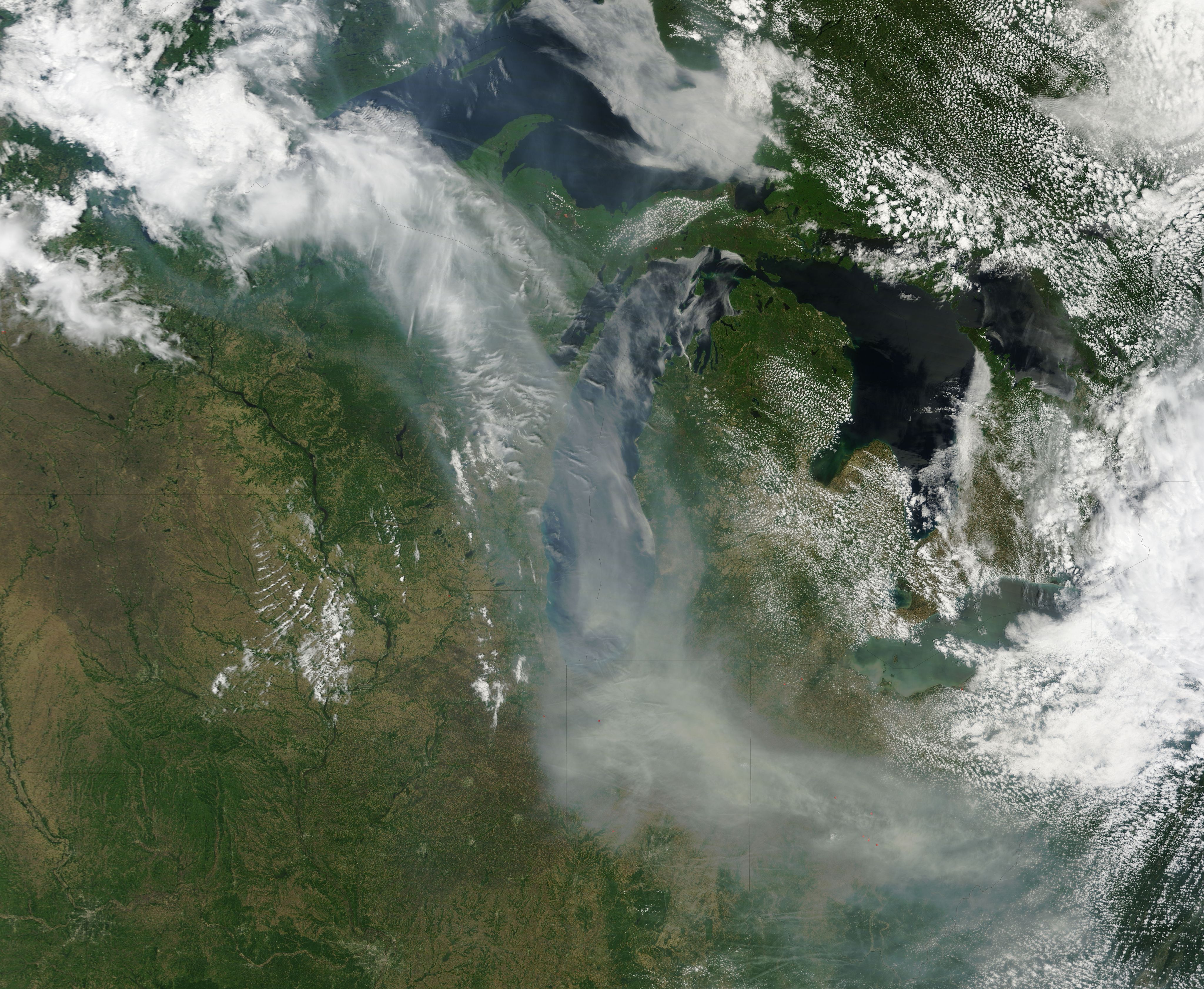
Loría-Salazar and her team can use this information to track aerosols, studying how they change as they move over land, change altitude, and interact with other atmospheric particles. Her goal is to better understand how these aerosols affect human health when they’re inhaled. Her team works with the Oklahoma state government to develop solutions to improve air quality decision-making.
She also works with tribal nations to help inform air quality decisions in their communities. For example, setting prescribed fires is a traditional activity to preserve ecosystems, but the fires do put smoke into the air. By using satellite data, tribal managers can make better-informed decisions about the potential risk of acute smoke exposure on a given day.
Tracking Health of Marine Mammal Ecosystems
Phytoplankton are the center of the marine food web. These microscopic organisms are food for bigger animals like zooplankton, fish, and shellfish – and ultimately whales and dolphins. While PACE can’t directly detect fish or mammals below the surface of the ocean, it can view communities of phytoplankton, which can inform scientists about the ocean ecosystem in which fish and mammals live.

By examining phytoplankton, scientists can gain valuable insights into changes occurring within marine habitats, as these microorganisms often serve as early indicators of regional ecosystem health. Liz Ferguson, CEO and marine ecologist for Ocean Science Analytics, studies marine mammals off the Pacific Coast of North America.
Monitoring plankton communities enhances scientists’ ability to perceive the intricate dynamics within marine ecosystems. By closely monitoring shifts in environmental variables and the behavior of indicator species such as marine mammals, Ferguson can study the impact of climate change on the California current's ecosystems.
Doubling Up Satellite Data
Some species of phytoplankton produce toxins that can be dangerous for humans, pets, and livestock. When these phytoplankton multiply to large numbers, it’s called a harmful algal bloom.
Richard Stumpf and Michelle Tomlinson, oceanographers with the National Oceanic and Atmospheric Administration (NOAA), use satellite data to study these blooms and help inform communities about their risks. They have been using data from the Ocean and Land Color I nstrument on the European Space Agency's Sentinel-3 satellite , which captures Earth data by measuring certain wavelengths of light. PACE’s Ocean Color Instrument sensor does the same, but as a hyperspectral instrument, it can detect more than 200 wavelengths – more than five times the number observed by Sentinel-3 and other current instruments.
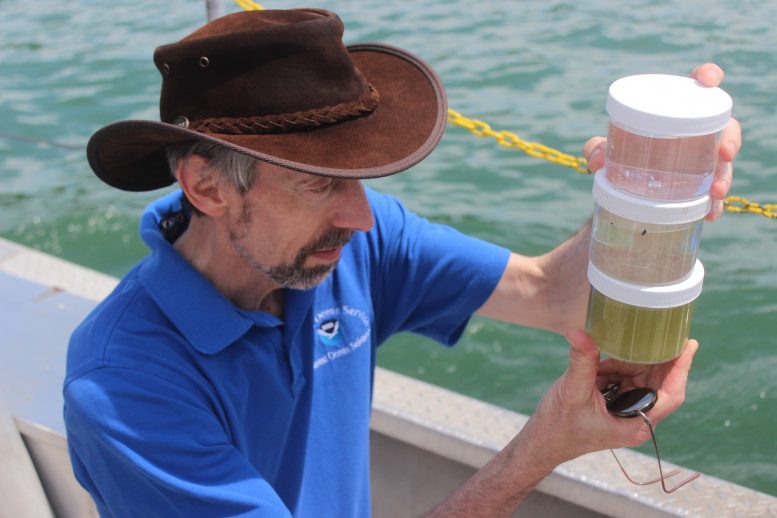
PACE data can help Stumpf and Tomlinson continue their research on how the color of harmful algal blooms change over time and space. Choosing specific wavelengths of data from PACE can also help verify the data from Sentinel-3 and extend the long-term data record.
The hyperspectral capabilities of PACE can allow scientists and environmental managers to not only spot emerging blooms, but also identify the specific communities of phytoplankton that make up the bloom. Detecting these details helps scientists better inform local water managers about the location, timing, and type of harmful algal blooms, which can help mitigate risks to the public.
About the Author
Erica mcnamee, related terms, explore more.
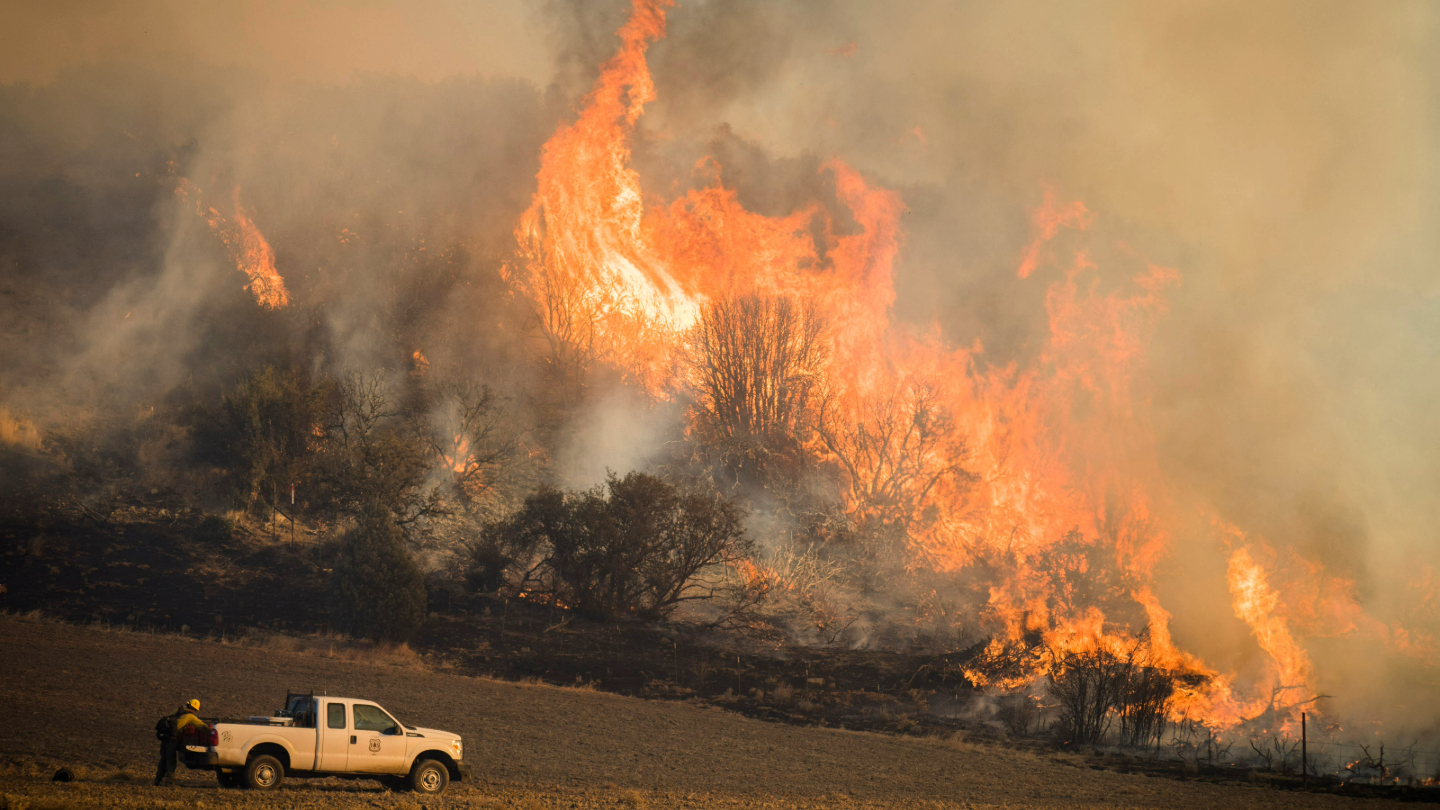
NASA Data Shows How Drought Changes Wildfire Recovery in the West

Antarctic Sea Ice Near Historic Lows; Arctic Ice Continues Decline
Sea ice at both the top and bottom of the planet continued its decline in 2024. In the waters around Antarctica, ice coverage shrank to near-historic lows for the third year in a row. The recurring loss hints at a long-term shift in conditions in the Southern Ocean, likely resulting from global climate change, according […]
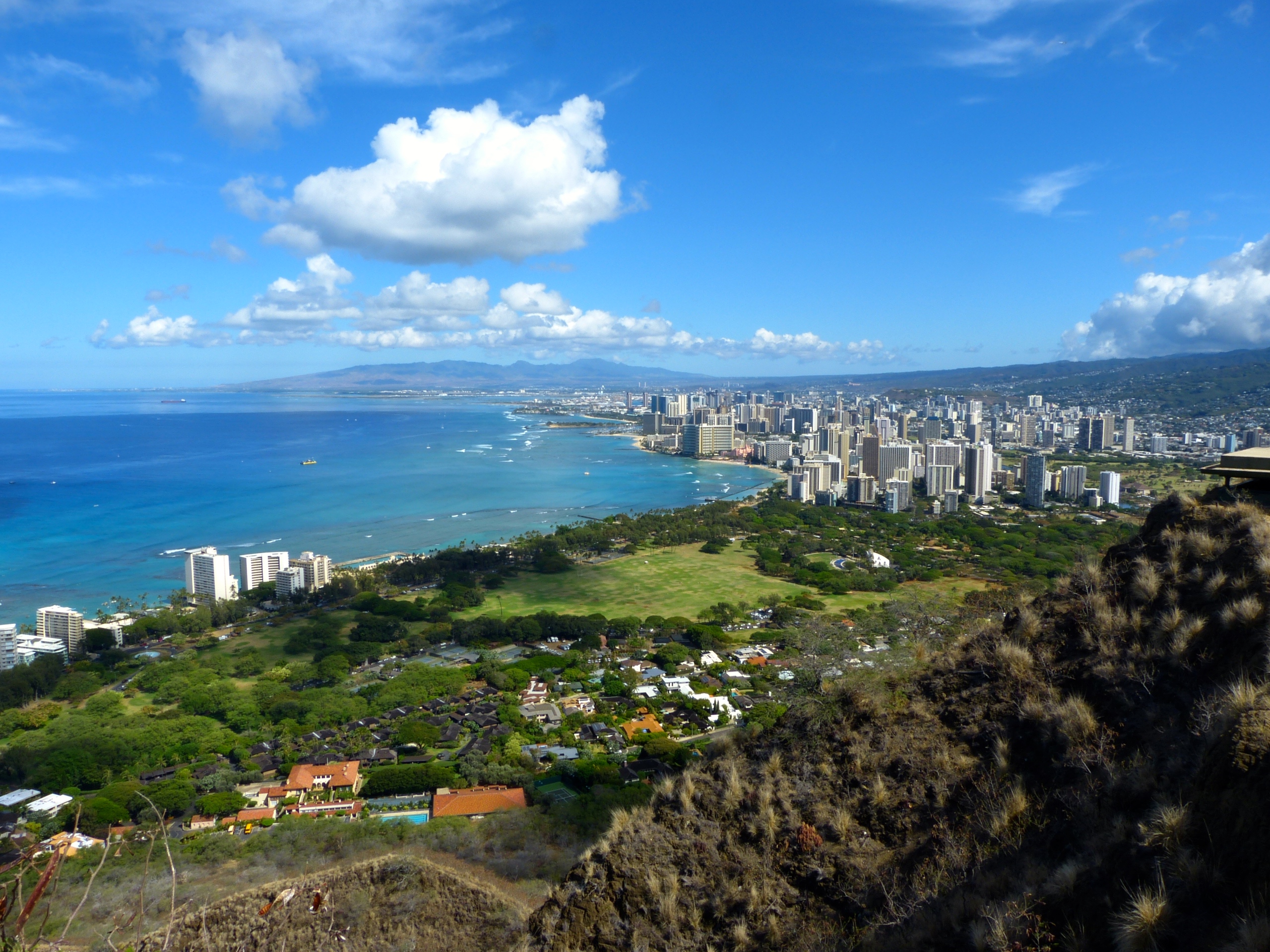
NASA Analysis Sees Spike in 2023 Global Sea Level Due to El Niño
A long-term sea level dataset shows ocean surface heights continuing to rise at faster and faster rates over decades of observations. Global average sea level rose by about 0.3 inches (0.76 centimeters) from 2022 to 2023, a relatively large jump due mostly to a warming climate and the development of a strong El Niño. The […]
- Air company SCAT
- Astana - Moscow (Vnukovo)

Classic Uzbekistan Group Tour 2024-2025
Our most popular escorted tour of Uzbekistan in a small group will acquaint you with the most famous ancient cities in Uzbekistan: Khiva, Bukhara and Samarkand, as well as the modern capital, Tashkent.
Tashkent, Khiva, Bukhara, Samarkand
8 Days | Spring, summer, autumn | from US$ 1,160 per person
Astana - Moscow (Vnukovo) Flights
Winter 2019 - 2020 schedule.
Astana (TSE) - Moscow (Vnukovo) (VKO)
Moscow (Vnukovo) (VKO) - Astana (TSE)
- Preplanned tours
- Daytrips out of Moscow
- Themed tours
- Customized tours
- St. Petersburg
Moscow Metro
The Moscow Metro Tour is included in most guided tours’ itineraries. Opened in 1935, under Stalin’s regime, the metro was not only meant to solve transport problems, but also was hailed as “a people’s palace”. Every station you will see during your Moscow metro tour looks like a palace room. There are bright paintings, mosaics, stained glass, bronze statues… Our Moscow metro tour includes the most impressive stations best architects and designers worked at - Ploshchad Revolutsii, Mayakovskaya, Komsomolskaya, Kievskaya, Novoslobodskaya and some others.
What is the kremlin in russia?
The guide will not only help you navigate the metro, but will also provide you with fascinating background tales for the images you see and a history of each station.
And there some stories to be told during the Moscow metro tour! The deepest station - Park Pobedy - is 84 metres under the ground with the world longest escalator of 140 meters. Parts of the so-called Metro-2, a secret strategic system of underground tunnels, was used for its construction.
During the Second World War the metro itself became a strategic asset: it was turned into the city's biggest bomb-shelter and one of the stations even became a library. 217 children were born here in 1941-1942! The metro is the most effective means of transport in the capital.
There are almost 200 stations 196 at the moment and trains run every 90 seconds! The guide of your Moscow metro tour can explain to you how to buy tickets and find your way if you plan to get around by yourself.
Tulum airport opens to U.S. flights, helping tourists skip Cancún crowds
New routes from american, delta and united connect the beach destination to hubs like atlanta, dallas and miami.
Traveling to the Mayan Riviera in Mexico is about to get easier.
Starting this week, visitors to the east coast of the Yucatán Peninsula can say goodbye to the crowded halls of the Cancún airport and potentially hours-long drive south; U.S.-based flights to recently opened Tulum International Airport start Wednesday.
American Airlines and Delta Air Lines begin flights on March 28, followed by United Airlines on March 31. The new routes will connect Tulum to major hubs like Atlanta, Dallas-Fort Worth, Houston , Miami, and Newark.
Air Canada starts flying to Tulum in May, and JetBlue Airways and Panama’s Copa Airline s in June.
“Imagine taking a morning flight from the United States, and by lunchtime, you’re sipping margaritas on our beautiful beach,” said Laura Diver, the marketing manager for Colibri Boutique Hotels , which manages several properties in Tulum.
A bumpy start
The Tulum airport, like many of the big recently opened infrastructure projects championed by Mexican President Andrés Manuel López Obrador, remains a work in progress.
Construction continues despite some domestic flights beginning in December. Karla Cayetano, a reservations manager at the Kanan Tulum resort, said workers were still “finishing some details” to the terminal and access road. Despite this, she said some of the resort’s guests are already arriving there rather than to Cancún.
Ground transportation options are limited and costs are high. David Ortiz Mena, the president of the Tulum Hotel Association, highlighted this as a “great concern” in a December statement . Talks with the airport and government authorities over lowering the ground transportation tax were still underway in mid-March.
And protesters have blocked the access road to the airport, and adjacent Tren Maya station, over land rights.
The issues are not unlike those that have plagued the Tren Maya since it opened in December. Trains are limited and delays are frequent on the ambitious and controversial 947-mile passenger rail loop pushed by the Mexican president. The booking system has been unreliable . Much of the track that will eventually encircle the Yucatán has yet to open.
But the Tulum airport, like the Tren Maya, is widely expected to significantly improve access to the Mayan Riviera once the kinks are worked out.
Alternative to Cancún
The Mayan Riviera is one of the most popular beach destinations in Mexico. It stretches from north of the all-inclusive resorts of Playa del Carmen to south of chic Tulum, with its beachside Mayan ruins.
Last year, the Riviera Maya boasted the most available hotel rooms — and occupied rooms — in the country, beating nearby Cancún and Los Cabos on the Pacific coast, according to data from the government of Mexico’s tourism secretary.
The Cancún airport is the main gateway for visitors to the region. In fact, last year the airport was the main gateway to all foreign visitors to Mexico, and the most popular among American tourists. A presentation from Mexico’s tourism secretary shows nearly 4.8 million American visitors to Mexico passed through the Cancún airport last year, representing more than a third of all the Americans who visited the country.
That’s why airlines are clamoring to fly to Tulum, even with its early issues. The new airport gives travelers an alternative to the busy Cancún airport.
“We’re pretty excited about some of the [travel] demand we’re seeing,” said Amy Martin, vice president of North America network planning at Delta.
More on air travel
Leave flying to the pros: Think you could land a plane in an emergency? Experts say you’re wrong . Here’s what you should actually do if something goes awry during a flight .
Pet peeves: Why do “gate lice” line up early for a flight ? Psychologists explained for us. Another move that annoys airline workers: abusing the flight attendant call button . For more on how to behave on a flight, check out our 52 definitive rules of flying .
Plane mess: Stories about extremely disgusting airplanes have been grossing out travelers. The question of plane cleanups became the subject of a recent debate after a flight attendant allegedly told a pregnant passenger to pick up the popcorn spilled by her toddler.
Frequent flying: Airline status isn’t what it used to be, but at least there are some good movies and TV shows to watch in the air. And somewhere out there, experts are trying to make airline food taste good.


An official website of the United States government
Here’s how you know
Official websites use .gov A .gov website belongs to an official government organization in the United States.
Secure .gov websites use HTTPS A lock ( Lock A locked padlock ) or https:// means you’ve safely connected to the .gov website. Share sensitive information only on official, secure websites.
What Can I Bring?
Planning ahead and packing properly can facilitate the screening process and ease your travel experience at the airport. Know what you can pack in your carry-on and checked baggage before arriving at the airport by reviewing the lists below. Even if an item is generally permitted, it may be subject to additional screening or not allowed through the checkpoint if it triggers an alarm during the screening process, appears to have been tampered with, or poses other security concerns. Read about civil penalties for prohibited items .
- Twitter: @AskTSA
- Facebook Messenger: www.fb.com/AskTSA
- Apple Business Chat: AskTSA
- Text Message: Text "Travel" to AskTSA (275-872)
The final decision rests with the TSA officer on whether an item is allowed through the checkpoint.
Officers may ask you to power up your electronic device, including cell phones. Powerless devices will not be permitted onboard the aircraft. TSA does not read or copy information from your device.


IMAGES
COMMENTS
TSA's 3-1-1 Liquids Rule. You are allowed to bring a quart-sized bag of liquids, aerosols, gels, creams and pastes in your carry-on bag and through the checkpoint. These are limited to travel-sized containers that are 3.4 ounces (100 milliliters) or less per item. Placing these items in the small bag and separating from your carry-on baggage ...
And since an aerosol can contains liquid, it must comply with the TSA liquids rules if you're going to fly with aerosols. Can you take aerosols on a plane? Yes, but know the rules first. As a reminder, the TSA liquids rule states that all liquids in your carry on baggage must be in containers of 3.4 ounces (100ml) or smaller.
If you want to pack aerosols in your checked baggage, there are still restrictions, though they are far looser. "The total aggregate quantity per person cannot exceed 2 kg (70 ounces) or 2 L (68 fluid ounces). The capacity of each container must not exceed 0.5 kg (18 ounces) or 500 ml (17 fluid ounces).".
The TSA's liquid limit for carry-ons—known as the 3-1-1 rule—allows travelers to pack liquids, aerosols, gels, creams, and pastes under 3.4 ounces (100 milliliters) in their carry-on bags. Passengers are allowed up to one quart-sized bag per person, or roughly nine 3.4-ounce containers in a single quart-sized bag.
If flying within the US, the FAA has a table of items that are allowed and forbidden on airplanes (either as checked or carry-on luggage). From that table, you can see that, for instance, aerosol sunscreen is allowed, pressurized whipped cream is allowed in checked luggage but not carry-on, and spray paint is completely forbidden.
Aerosol Air Travel Tips. Preparing your luggage for air travel has become increasingly complicated, especially when it comes to toiletries. For many airlines, aerosols in particular are a cause for confusion because they contain flammable gases. Aerosols are completely safe. Just stick to some basic rules when taking them on a plane.
Will Aerosol Cans Explode on A Plane. Aerosols are unlikely to explode on a plane due to regulated pressure and temperature in cargo holds. The FAA permits aerosols in checked luggage with a maximum of 18 ounces per container and 70 ounces total per person. For carry-on, aerosol containers must be 3.4 ounces or less within a quart-sized bag.
Although you can take quite a few aerosols in checked luggage, there is a limit on the size and total amount. The TSA website states that "toiletry aerosols" that are carried in a checked bag must not exceed 70oz (68 fluid ounces) in total, and each container must be 18oz (16 fluid ounces) or less. Unless you are a traveling aerosol ...
Droplets are relatively heavy. So they usually fall to the ground within two seconds and don't travel much beyond 6 feet. Masks and social distancing can help prevent the spread of droplets. Aerosols: These particles are lighter, smaller and can float. Aerosols could stay aloft for minutes or hours in poorly ventilated indoor areas, thus ...
Good news, folks! You can bring aerosol cans on a plane, but there are some rules you need to follow. The main thing to remember is that aerosol cans, like hair spray, dry shampoo, and deodorant, must comply with the TSA' s 3-1-1 rule for carry-on bags. The 3-1-1 liquids rule states passengers can bring 3.4-ounce (100 ml) containers of ...
The COVID-19 pandemic showed what can happen if the humans reduce their aerosol pollution. Fossil-fueled air travel, driving, electricity use, and industrial activity all decreased sharply in the spring of 2020. This led to cleaner, clearer air, which caused a slight warming-- up to 0.2 to 0.5
Chemicals in scented products can create headaches, nausea, upper respiratory problems, and skin irritation. It's time for the scent war to end on the plane. Wait until you land to slather on the ...
Say something. Find someone who can help you. A flight attendant might be able to move you to a different seat or, if the flight hasn't left yet, remove the offending smeller. "Politely tell ...
Although most aerosols remain suspended in the atmosphere for short periods—typically between four days and a week—they can travel vast distances. Particles moving with the atmosphere at 5 meters (16.4 feet) per second will travel thousands of kilometers in a week. Dust plumes from the Sahara frequently cross the Atlantic and reach the ...
The distance that virus-laden aerosols travel depends on aerosol size, initial velocity of the flow carrying them, and other environmental conditions, such as outdoor wind speed or indoor air currents induced by natural ventilation or heating, ventilation, and air conditioning (HVAC) systems (117, 118).
The size and composition of aerosol particles affects how far they can travel around the world, their interactions with solar and thermal radiation, and their potential effects on health. Aerosols injected into the atmosphere directly are known as 'primary aerosols'. Sea spray, mineral dust, smoke, and volcanic ash are all primary aerosols.
The PM2.5 concentration was measured—meaning fine particulate aerosol particles measuring up to 2.5 microns in diameter—as the primary air quality indicator for this study.
Deodorant (aerosol) Carry On Bags: Yes (Less than or equal to 3.4oz/100 ml allowed) The FAA limits the total amount of restricted medicinal and toiletry articles, including aerosols, in checked baggage. The total aggregate quantity per person cannot exceed 2 kg (70 ounces) or 2 L (68 fluid ounces). The capacity of each container must not exceed ...
Algae, Aerosols, and Asthma. 12:00 pm, Tue March 26, 2024 - Ohio Sea Grant researchers recently made a breakthrough in understanding the risks of breathing in "aerosolized" algal toxins, finding evidence that airway exposure to the algal toxin microcystin can create an inflammatory response in lungs. When harmful algal blooms arise on Lake ...
Air travel safety See all topics The area of the fuselage of a Boeing 737-9 Max where a door plug blew out on a January 5 Alaska Air flight. The incident has sparked increased attention to air ...
The FAA estimated that any air travel impacts from the eclipse would be felt from April 7 at 6 a.m. until April 10 at midnight. "While most travelers are heading to their favorite vacation ...
The airline expects to launch overnight flights from Las Vegas and Hawaii. By Edward Russell. March 22, 2024 at 2:01 p.m. EDT. (Washington Post illustration; iStock) 4 min. Southwest Airlines is ...
From the atmosphere down to the surface of the ocean, data from NASA's PACE (Plankton, Aerosol, Cloud, ocean Ecosystem) satellite benefits ecosystems, human health, and underrepresented communities. Years before the launch in February 2024, mission leaders from NASA teamed with dozens of applied scientists and environmental professionals to prepare for the many practical uses that […]
Note: Astana - Moscow (Vnukovo) flights schedule is subject to change without notice. Note: Winter schedule of Astana - Moscow (Vnukovo) flights is valid from 28 November 2019 through 31 March 2020.
The Moscow Metro Tour is included in most guided tours' itineraries. Opened in 1935, under Stalin's regime, the metro was not only meant to solve transport problems, but also was hailed as "a people's palace". Every station you will see during your Moscow metro tour looks like a palace room. There are bright paintings, mosaics ...
Traveling to the Mayan Riviera in Mexico is about to get easier. Starting this week, visitors to the east coast of the Yucatán Peninsula can say goodbye to the crowded halls of the Cancún ...
Understanding how biomass burning aerosols travel vertically is important in regulating their impacts on weather and climate. But until now, researchers couldn't accurately model aerosol distribution because state-of-the-art global Earth system models didn't account for fire intensity. Instead, they simply assumed the injection heights of biomass burning aerosols around the world.
Check with Airline: Dry Shampoo (aerosol) The FAA limits the total amount of restricted medicinal and toiletry articles, including aerosols, in checked baggage. The total aggregate quantity per person cannot exceed 2 kg (70 ounces) or 2 L (68 fluid ounces). The capacity of each container must not exceed 0.5 kg (18 ounces) or 500 ml (17 fluid ...